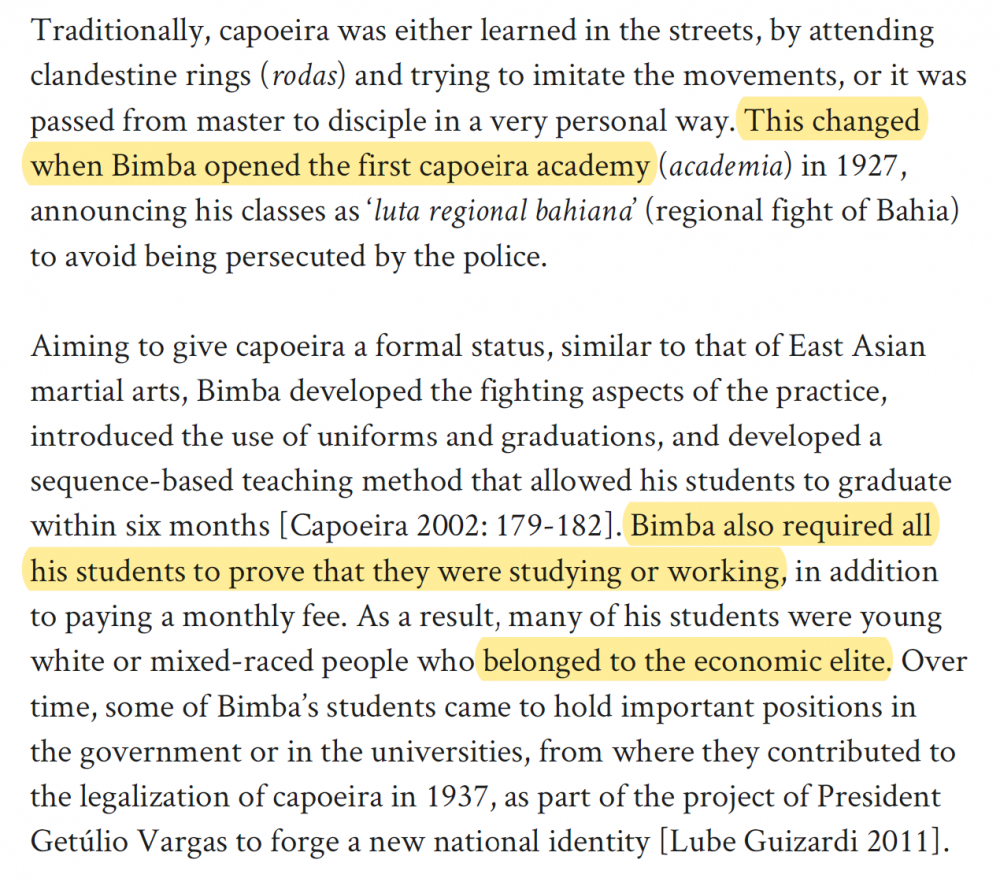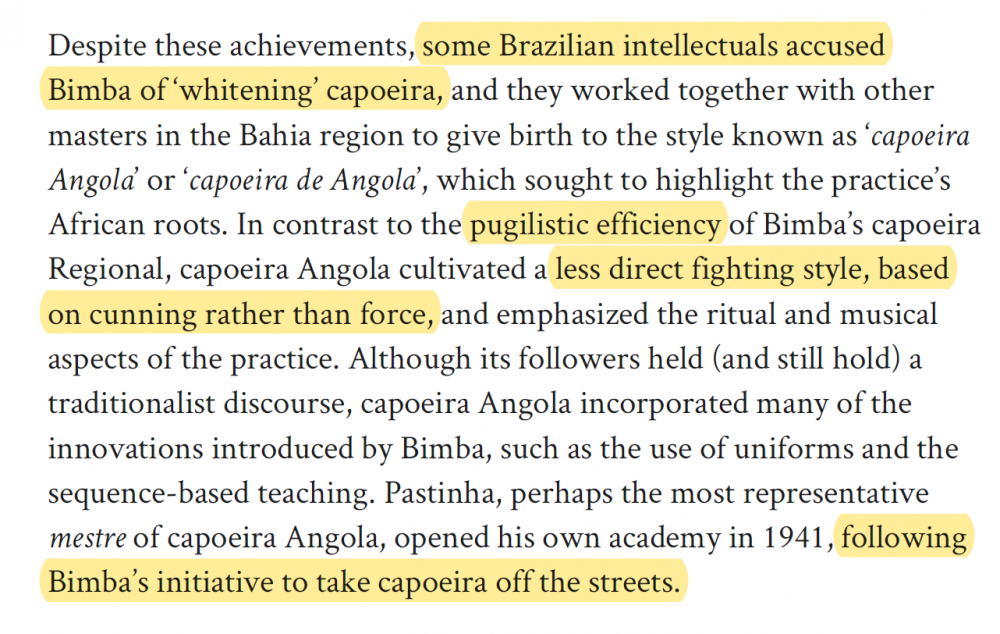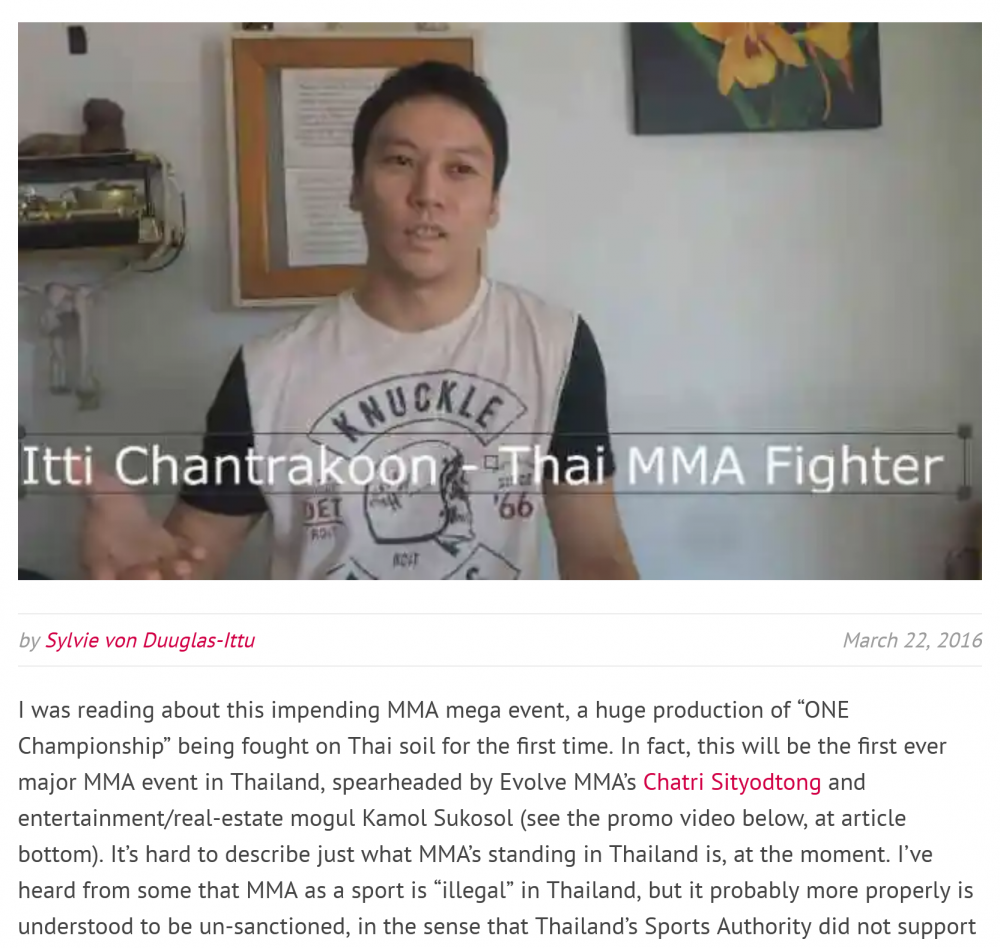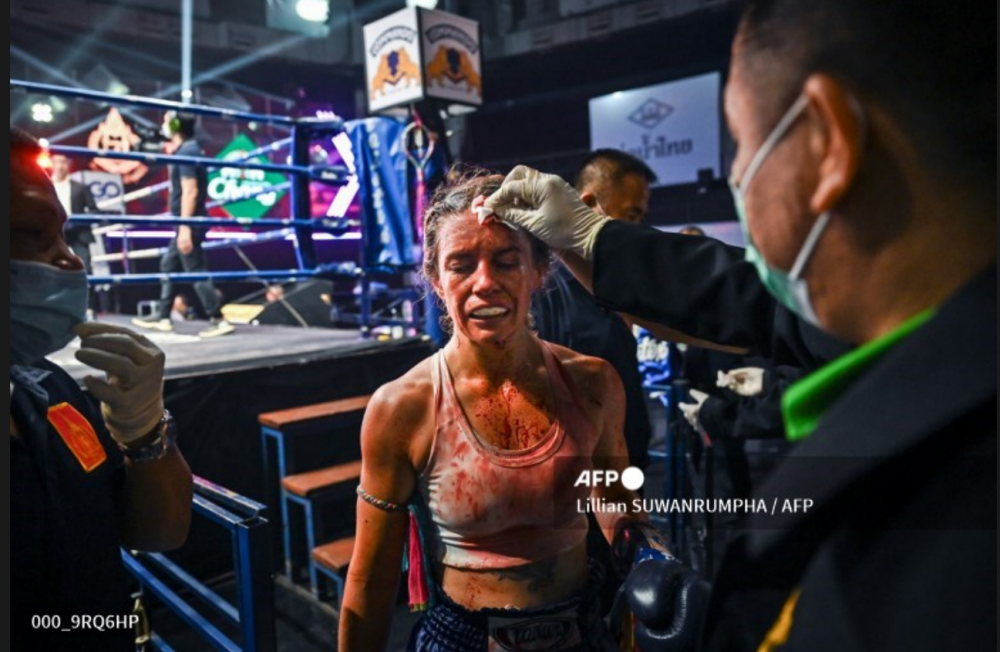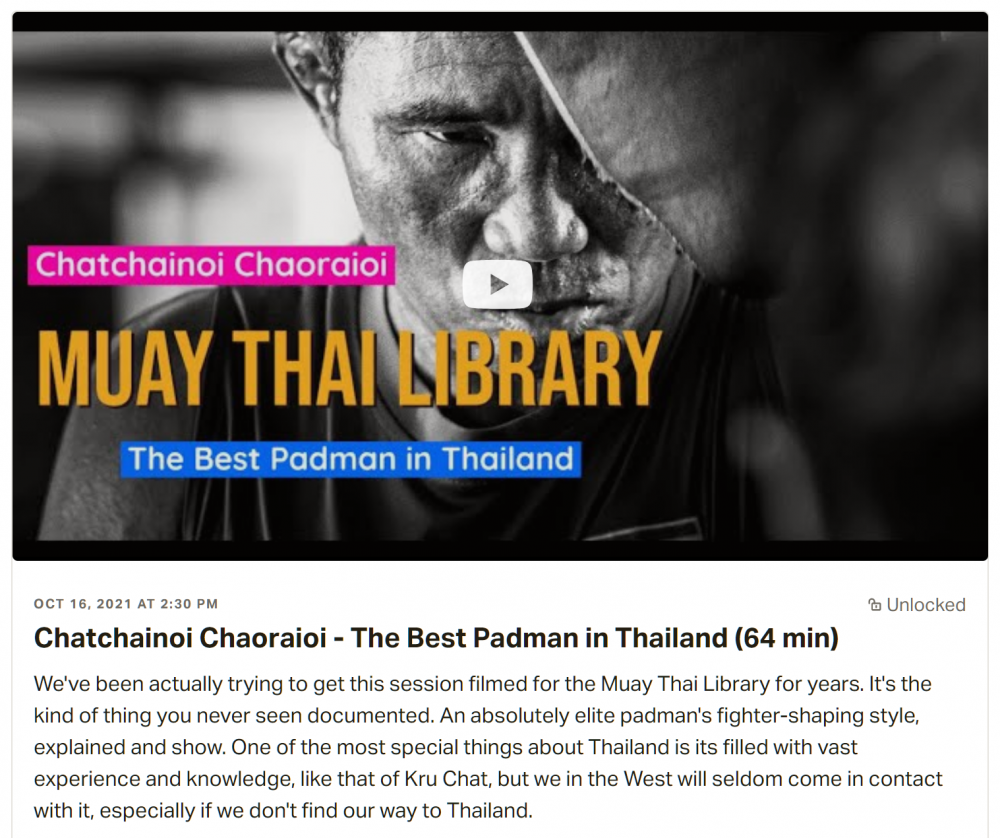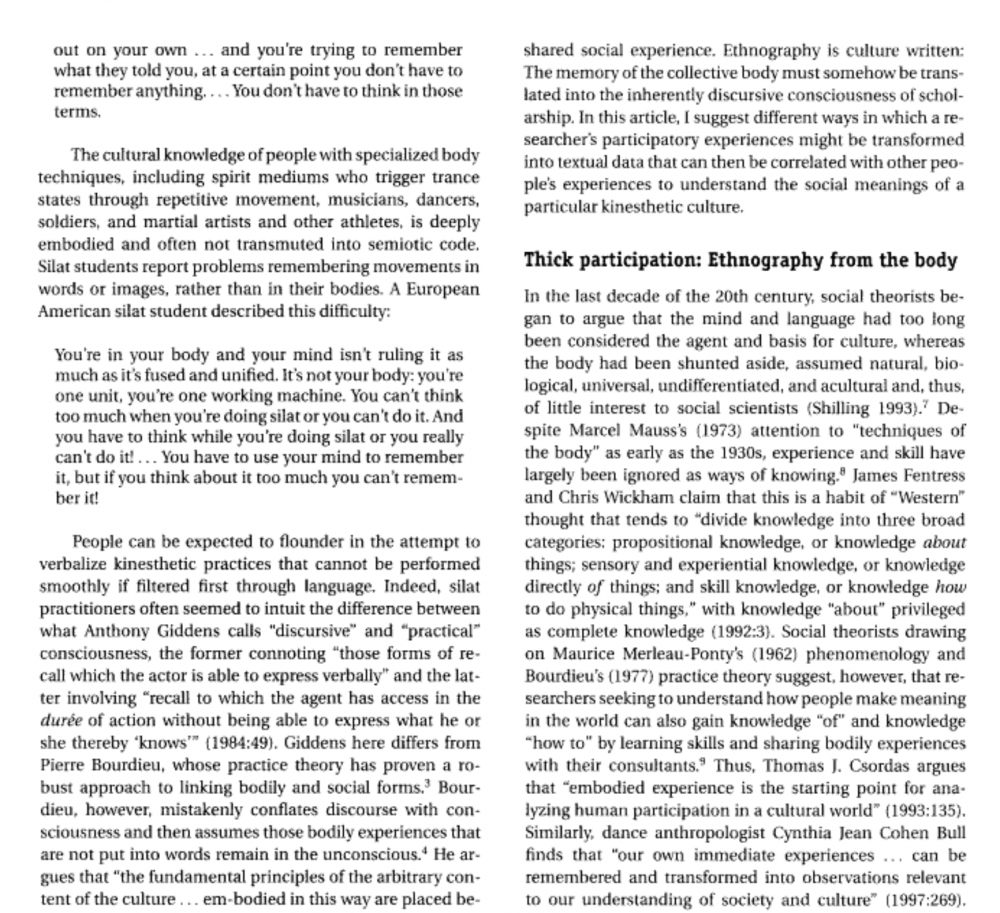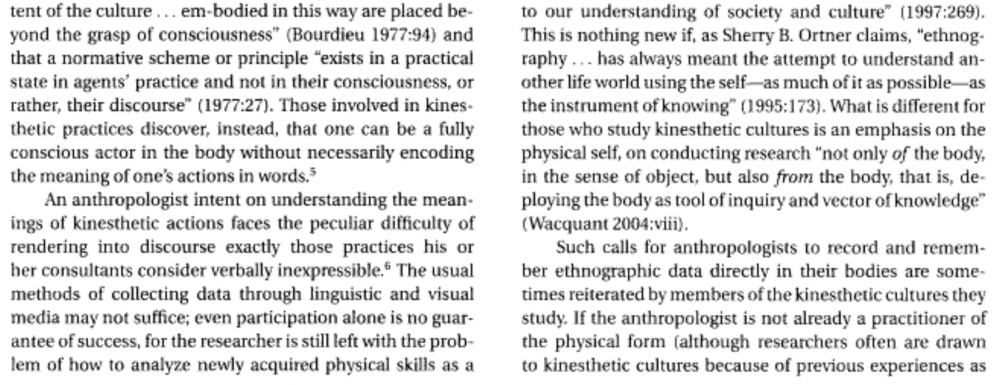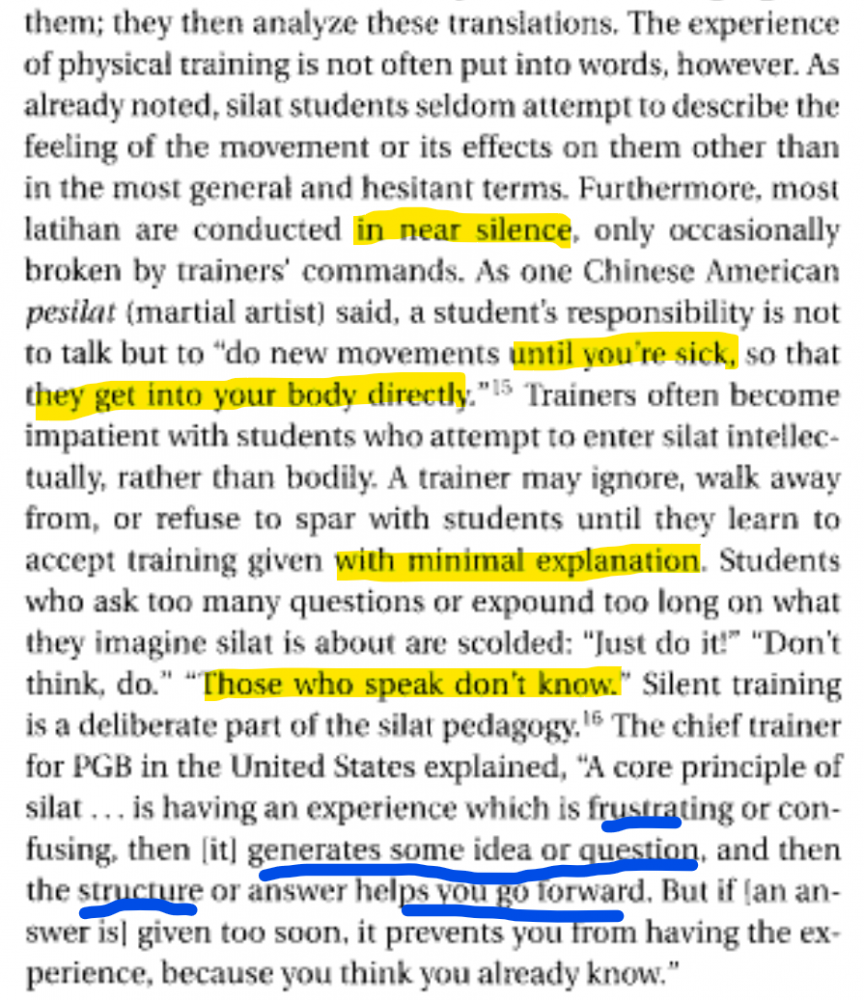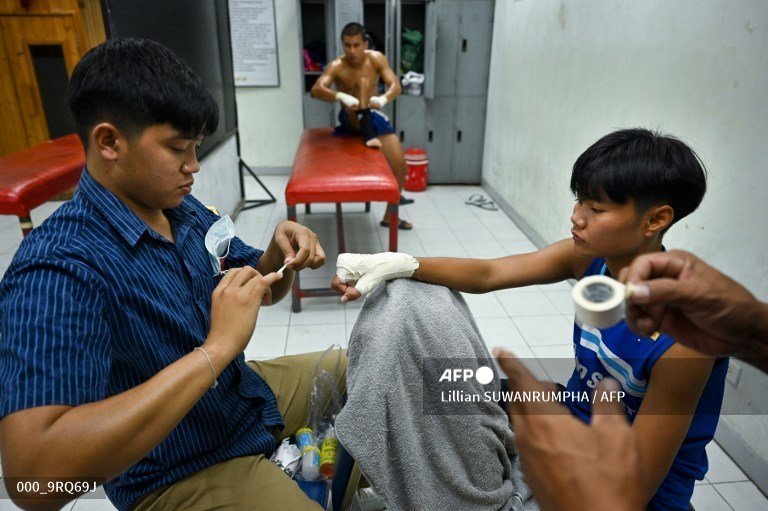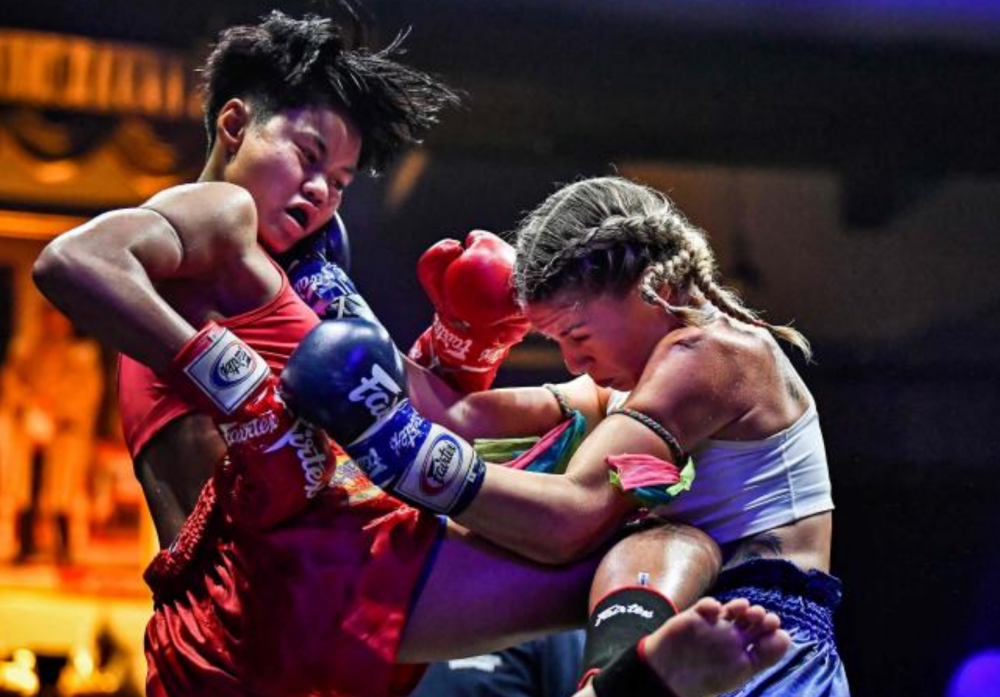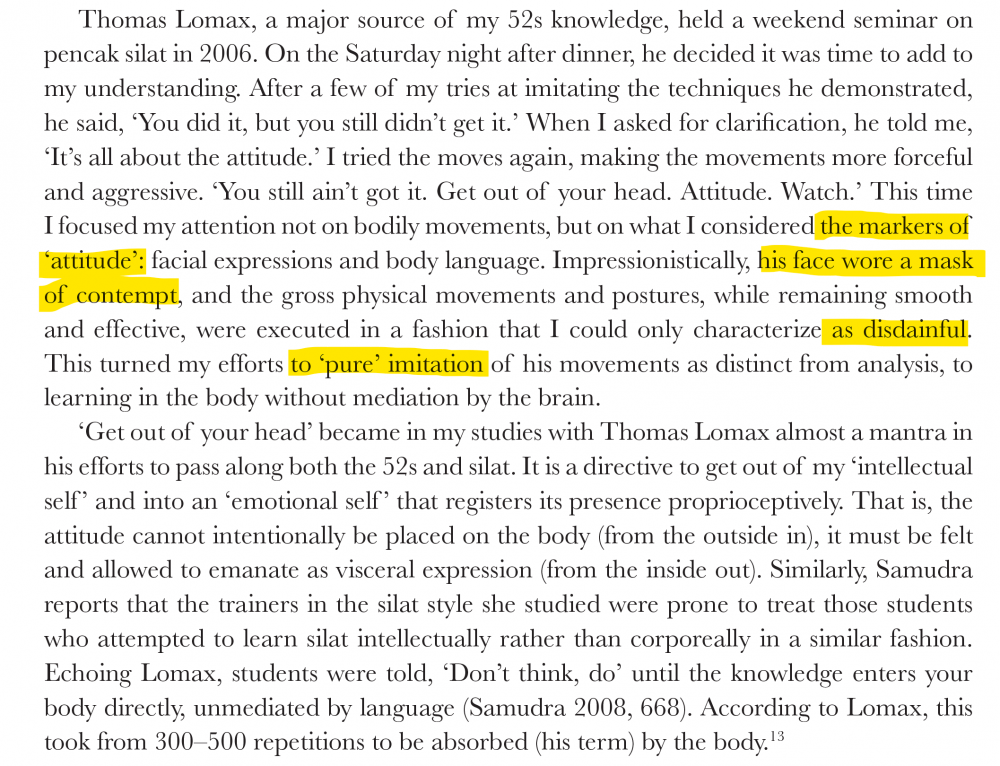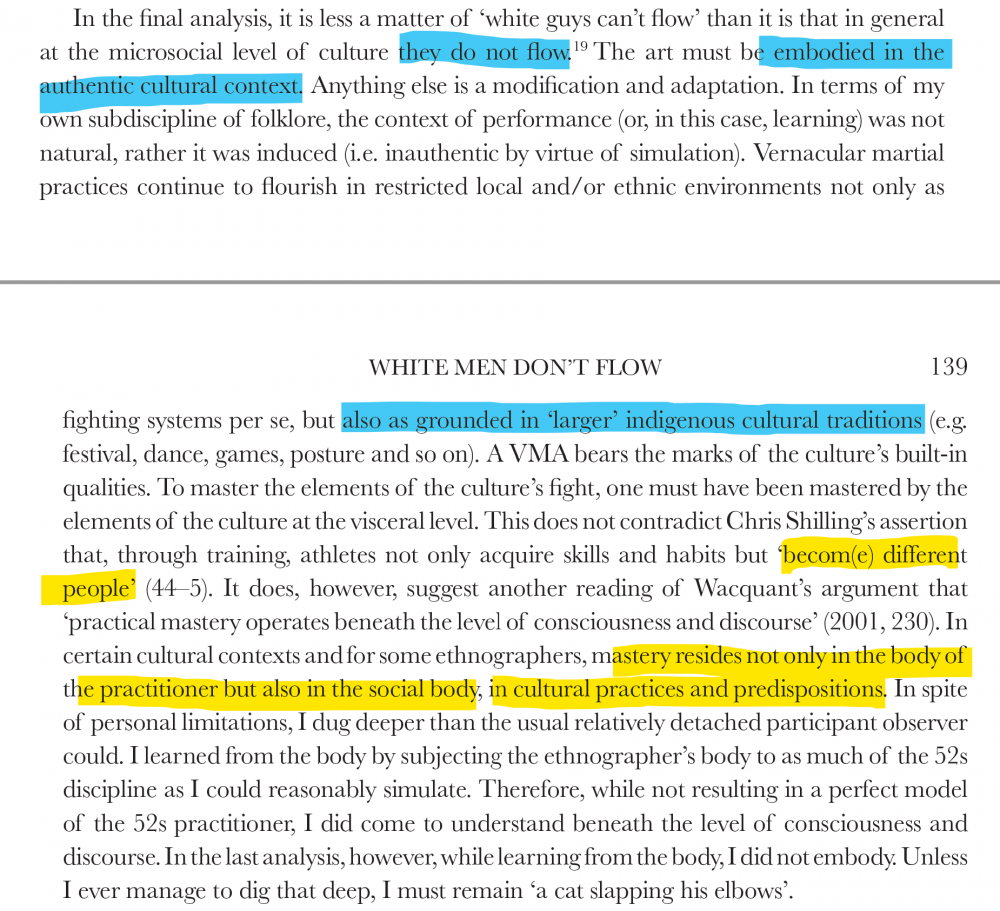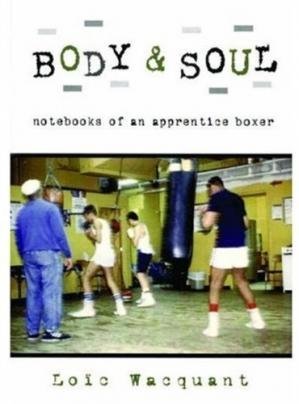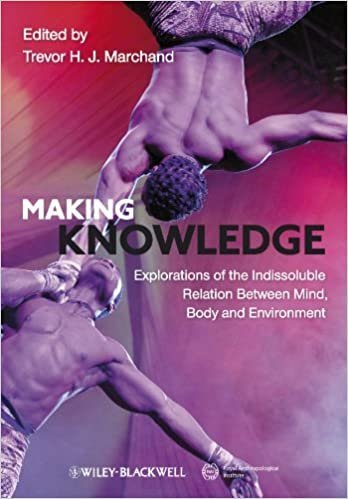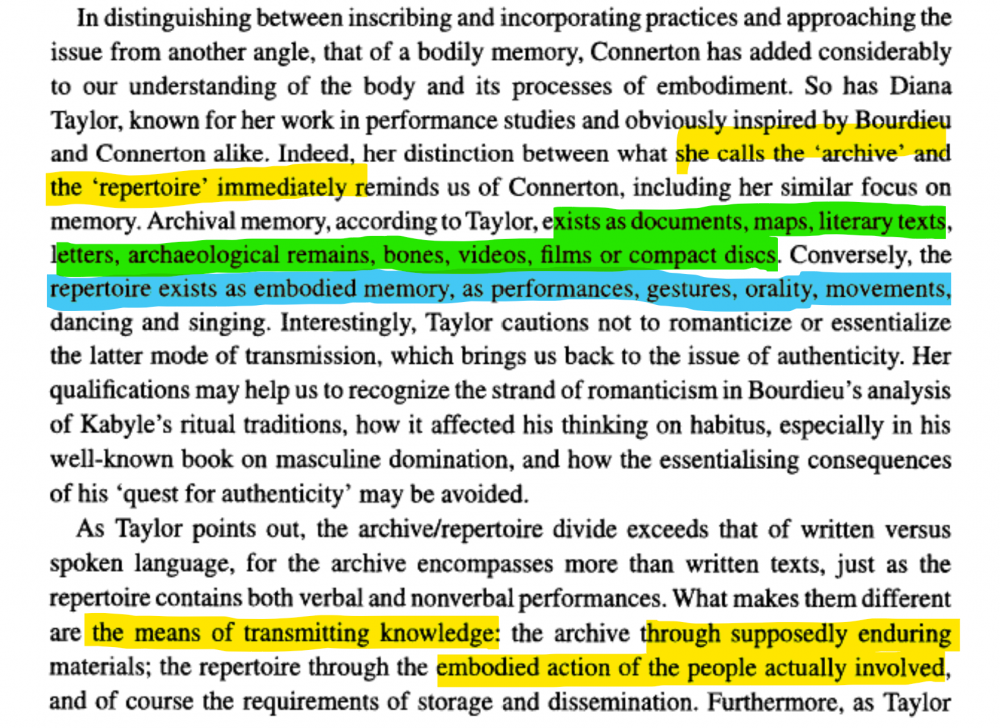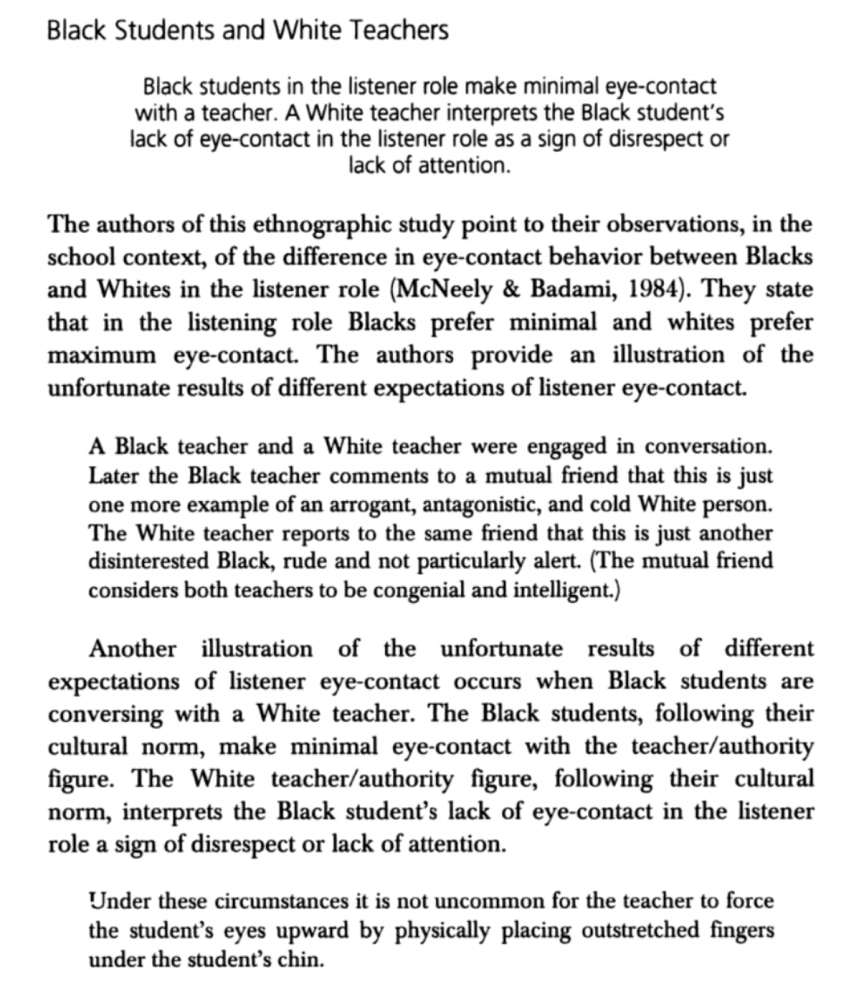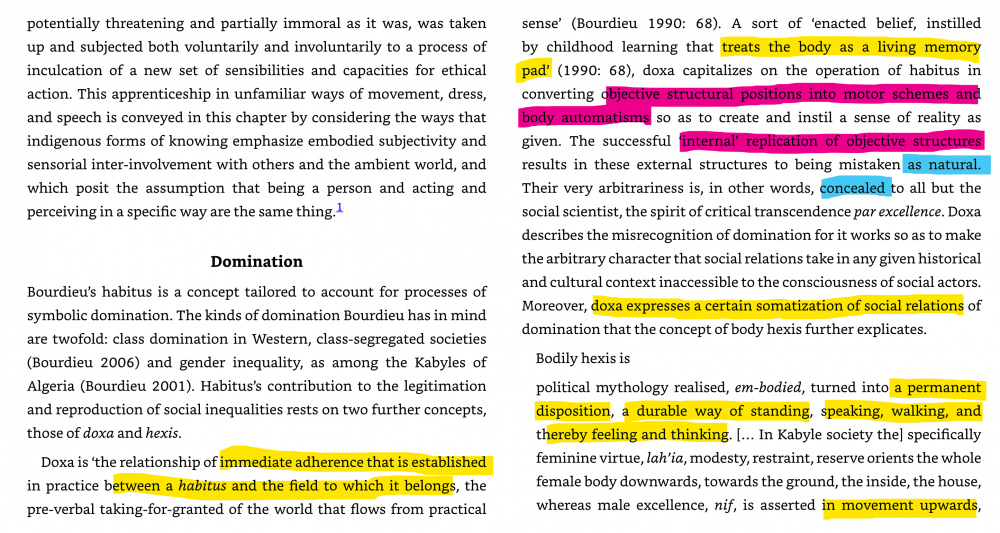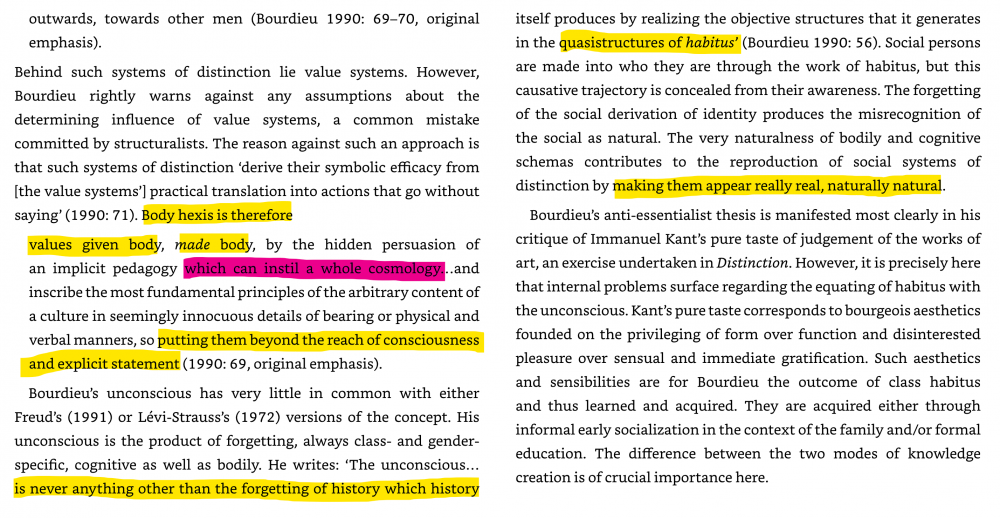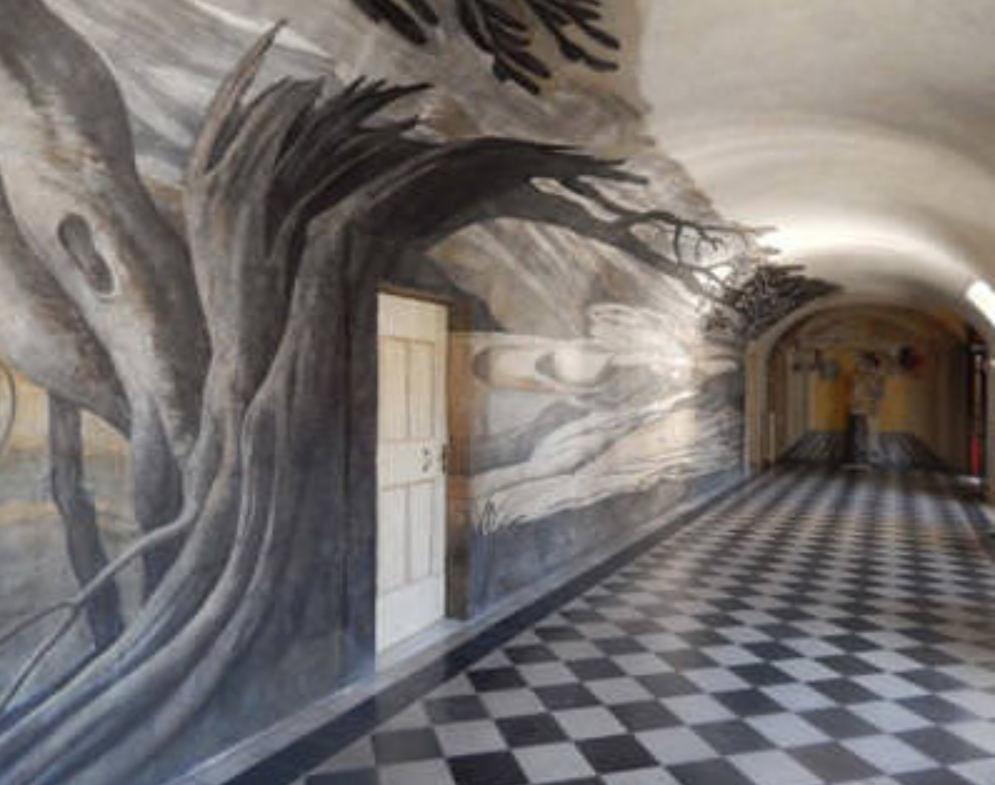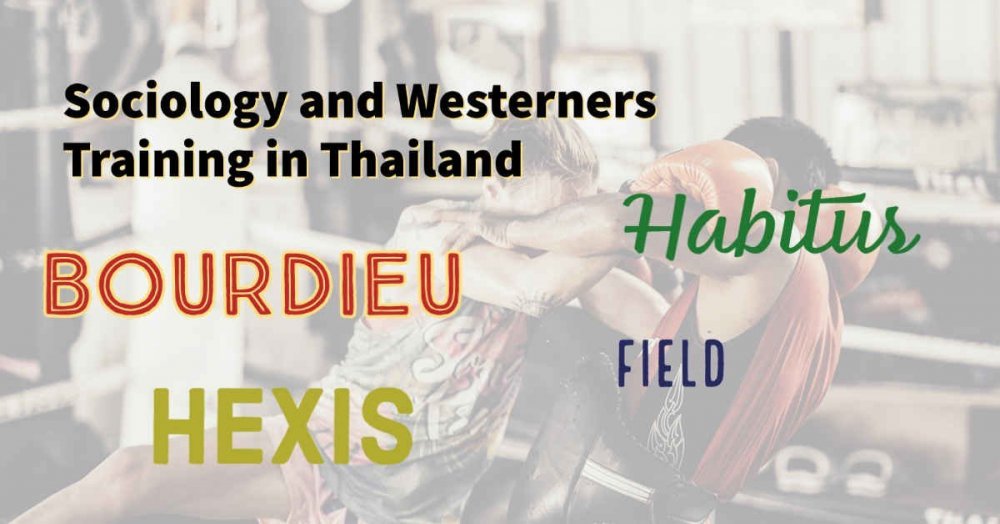-
Posts
2,264 -
Joined
-
Days Won
499
Everything posted by Kevin von Duuglas-Ittu
-
Seeing the Ungendered Body As Lines of Force quoting to begin... The above are the concluding thoughts of the excellent short article: Fight like a girl! An investigation into female martial practices in European Fight Books from the 14th to the 20th century by Daniel Jaquet. It presents in brief the basis of a coherent argument that though there are physiological differences between the sexes, distributed over a population, martial arts are about developing the advantages you can have that overcome any physical differences that might weigh against you. I present this argument about Muay Thai and women more at length in: The “Natural” Inferiority of Women and The Art of Muay Thai. Just as shorter fighters can fight (and beat) taller fighters, smaller fighters can beat heavier fighters and slower fighters can beat faster fighters, whatever projected or real physiological differences between women and men there may be, they can be overcome. That is the entire point of a fighting art, especially any art stemming from combat contexts. Interestingly enough, Daniel Jaquet actually points to modern "institutional competition" as over-informing the way we think about the capacities of a fighting female. We think in terms of classified differences (weight classes, and even rulesets, etc), and one of these classifications is simply gender. Fight Like a Girl.pdf The article documents a conspicuous absence of women regarded as (possibly) equal combatants for nearly 700 years in combat literature, as gender became more codified in the European tradition. Jaquet marks a foothold in the timeline with this sword and shield technical manual in 1305 (Liber de arte dimicatoria), one of the last documentations of an assumed and illustrated gendered equivalence, at least for purposes of instruction. There is a great deal to think about in this topic at large, but here I'm most interested in the effects modernization, or rationalization of a fighting art can lead to ideas of gender equality, under fighting arts. And some of the ways modernization can push against it was well. Jaquet's finishing remarks (above) speak to this basic, rationalizing idea. Bodies are all different, they are all capable of differing physical actions, amounts of force being applied, speed of reaction times, etc. It follows, just as physical weaponry like swords or shields are force amplifiers, so too are the analogical "weapons and shields" (techniques) when practiced in a fighting art. If you know how to throw (or slip) a punch, you are within a force amplifier. The rationalization of fighting arts is a modernizing concept of extracting aspects of a traditional process of embodied knowledge practice, and classifying it, for pedagogic reasons, analysis, or commercial use. Seeing gendered bodies as force equations is rationalization. If you follow my writings you know that I have a great deal of hesitance regarding the eroding forces involved in the rationalization of fighting arts, both in terms of teaching and commercial performance (we can lose valuable and hidden habitus as we re-contextualize practices), but this does not mean that I wholesale resist rationalization/modernization. Instead it can act as a scissor, weaving and unweaving as it goes. As Jaquet points out, modernization itself also brings forth conventions which can regard important, liberating rationalizations of a fighting art. How Rationalized Jui-jitsu Changed the Early 20th Century Fight World What I'm really interested in is something that Jaquet does not pursue, and it's something that I have only touched on in my reading. What follows therefore is going to be only a broad sketch of intuitions that would be interesting areas of study. I was particularly struck by this 1905 photo included in his article: And the note tells us, this is the Duchess of Bedford training in Jiu-jitsu in England. I have not dug deeply into the history of Jiu-jitsu's immigration to England through Japanese masters, as well as other countries all over the world, but I assume this is part of a powerful rationalization impulse found in Japanese martial arts, much of it typified by Kanō Jigorō and his invention of Judo. Influenced by Western ideas of rational education and theories of utilitarianism Kano had the dream of modernizing traditional Jiu-jitsu along educational and health lines, and spreading this modernized version all over the world, eventually making it an Olympic sport. Judo and other forms of modern-leaning Jiu-jitsu spread internationally at this time, and the Duchess of Bedford's Jiu-jitsu no doubt was a part of this diaspora of the fighting art. Famously, it reached all the way down to Brazil, eventually becoming today's Brazilian Jiu-jitsu, but at this time it it also reached Siam (Thailand). King Vajiravudh of Siam (reign 1910-1925) was actually raised and educated in England in his youth and young adulthood, for nearly a decade before taking the throne. He brought with him not only an appreciation for British Boxing (which would deeply shape the development of Siam's Muay Thai), but also, one might expect, Judo/Jiu-jitsu which had growing presence in Britain. In 1907, two years after the photo of Mary Russell the Japanese community in Bangkok is recorded as teaching Jui-jitsu, in 1912 Prince Wabulya returns from study abroad in London having learned Judo, and teaches it to enthusiasts and in 1919 Judo is taught at the very important Suan Kulap College, along side British Boxing and the newly named "Muay Thai". It is enough to say that the modernization of Muay Boran into Muay Thai in the 1920s, in the image of Western Boxing (at the time Siam is making efforts to appear civilized in the eyes of the West), was part of an even larger, in fact world wide rationalization effort lead by Judo/Jui-jitsu. When we see this photo of Mary Russell in England, this is part of the one-and-the-same British movements of influence that created modern Muay Thai over the next decades (gloved, weight class, fixed stadium, rounds). Rationalization is happening. Notably, this unfolds it is in the context of King Chulalonkorn's previous religious reformation of Siam which would have lasting impact on the seats of Siam's Muay Thai, moving it away from temple teachings and magical practices. Siam is becoming a modern Nation, and the reformation of Buddhism (along with Muay Thai) is a significant part of that process: from The Modernization of Muay Thai – A Timeline Returning to the rationalizing efforts of British Jui-jitsu which will almost necessarily un-moor rooted gender bias, with even political consequences. As Jaquet writes, the medical/physical perspective of empowerment and health ended up expressing itself in the Suffragettes Self-Defense Club, to aid in physical confrontations with police: purportedly, the first photographically documented female fight in Siam (1929) image here Women would be granted the right to vote in Thailand in 1932 (the first of Asia's countries, not far behind the UK's 1918. But, this rationalizing equality would not progress. In fact Siam/Thailand over the next decades would become busy "civilizing" itself in the eyes of the West by importing the strong Victorian-inspired views of powerful visual differences between genders. Modes of dress, differentiating the sexes, were even at one point legally mandated by the government in the 1940s. What we today read as quintessentially "Thai" traditional attitudes towards the differences between the sexes though complex is actually, perhaps best explained as a Western value and practice importation during the first half of the 20th century. The visual differentiation of the sexes in dress: Thai cultural mandate #10 (1941): Polite international-style attire Civilizing the Savage and Savagizing the Civil What I'm interested in is the connection between the early 20th century rationalization/modernization of Jui-Juitsu in Britain, and today's rationalization-modernization of Muay Thai in Thailand. The schism between Thailand and Britain in terms of gender, under the guise of "civilization" recently and long last was symbolically bridged when women were finally integrated into Lumpinee Stadium promotion: The First Female Fight In Lumpinee Stadium Breaking the Prohibition. Note: the strong division between the genders of the late 1930s and 1940s in the "international-style" of work and dress is also in the context of the construction of Rajadamnern Stadium (1945) and Lumpinee Stadium (1956) under Thai fascism and Field Marshal Plaek Phibunsongkhram (Prime Minister 1938-1944 and 1948-1957). It is unknown what gendered Muay Thai practices may have developed without this heritage of an imitation of the West. As an contemporary outsider we tend to assume these "traditional" gendered differences as purely and essentially "Thai" and not a product of Western example or influence. Seeing these two photos, well over 100 years apart, in relationship to each other under the view of Internationalized Rationalization of fighting arts is fecund to examination. There is no clean line that leads between rationalization of the art and sport and the equality of the genders. Importantly, and not without irony, when King Vajiravudh modernized Muay Boran in imitation of British Boxing he was attempting to purge Siam and its fighting art of the impression of savageness. Contestants did die in the Kard Chuek ring (probably rarely) with rope-bound hands, but more importantly the use of feet and elbows of Siamese fighting was seen as primitive by British report. Codifying Muay Thai in the 1920s was no simple desire to just imitate the West as superior, as the West used the motive of civilizing "primitive" people to justify the colonization of peoples, including all the countries in Siam's orbit. No doubt King Vajiravudh had adopted many British aesthetics during his decade in British schooling, but there also something prophylactic to the transformation of Muay Thai before the eyes in the West. Now though, with some irony, Thailand is bending its fighting art to the Internationalist tastes of greater violence, more aggression, as part of a vision that is pushing it to join what might be seen as a globalized Combat Sports Industrial Complex, battling for eyeballs. And, as I say ironically enough, with this comes the rising commercial viability of women seen as equals. As Lumpinee Stadium seeks to Internationalize itself it brings in women, and also it brings in the "savagery" for which Siam's fighting was (politically and colonially) stigmatized over 100 years ago, as MMA comes to its storied name. The "Be more civilized!" and "Distinguish the genders!" that was once demanded by the colonizing West has become "Be more violent!" and "Equalize the genders!" by the globalizing West...a globalization that is actually now an Internationalist vision. What is missing from this story perhaps is the equivalence of Britain's Suffragettes Self-Defense Club, which is to say the way in which equality under a martial arts rationalization is connected to a broader political fight for women's equalities. From my view I suspect that the growing importance of respected female fighting in combat sports is an expression of the increased social and economic capital women have come to have in a globalized world. Women as having real and imagined physical prowess in the traditionally male-coded ring (and cage) symbolically manifests actual changes in female powers in society. Women in rings has grown out of the Suffragettes Self-Defense Club, not now equalizing themselves with embodied knowledge in the streets against police, but rather signifying their political and socio-economic heft to a globalized world. Yet, as all things bend back, the commercialized capture of symbolized female power in the ring is part of its re-domestication, as women's bodies become sites of judgement and eroticized re-packaging, problemizing any overriding narrative of liberty. As women are called to the ring under the auspices of aggression-first promotional fight theater in the double-bind navigation of globalized freedoms, the role of rationalization remains circumspect. Rationalization can and does lead to the re-codification of the genders, as we see with the conventions of institutional competition, as well as within the commodification of the female person and body by combat sport entertainment, yet it also holds the power to un-moor entrenched sexism and bias which work to restrict the possibilities of women as fighter who stands as proxy to the power of women in general.
-
Fighter Gyms in Bangkok
Kevin von Duuglas-Ittu replied to pbnaruto's topic in Gym Advice and Experiences
A worthwhile gym to look at is Fight House in Singburi, where Kru Diesel has taken up shop after years of running FA Group. One of the best Muay Khao krus in Thailand. I don't know their roster right now, but he's a great trainer and sending Thai fighters to stadium fights. -
Hmmm. I guess this depends on how old your son is [edit in: sorry, I missed that he was 14], and more about your own tolerance, or enjoyment of change is. Me? I like to settle down in a place. It is only after 3 days or more that I feel ok. When I know where I'm eating, the way to the gym, etc. Then maybe at 7-10 days do I really feel like I'm in something. It also depends on how heavily or often you want to train. Every day? Twice a day? Or taking days off? Just giving you my own sense, I'd say two weeks minimum for a single gym experience, once you know you like it, which means once you start moving again the next stay will feel shortened. When we first came to Thailand we committed in advance to two experiences over I think 6 weeks. I really loved our stay in Chiang Mai at Lanna at the time. Then, perfectly happy, we went down to Bangkok and Sasiprapa. The Bangkok experience wasn't bad in anyway, but we actually wished we had just stayed in Chiang Mai. It was far less gritty, the gym experience was really nice. It wasn't the worst thing to push for two, but it wasn't ideal. I would maybe make a first choice of location, and then a list of 3 gyms in that location. I'd go to each of them for a day and just feel what it is like and go by intuition. Can I picture myself here for 2 weeks? If you find a great one, one you really vibe on, then just stop there, no need to push for more. I'd give myself 10 days in that first choice gym. After about 7 of those days I'd reassessed. Do I want to change gyms? Or do I want to change cities? If you are really happy where you are, just stay. It's pretty easy, and not that expensive to just hop on a plane and be somewhere else if you suddenly get the urge to have a different experience. Don't pay for lots of days in advance, especially in the time of COVID when tourism is going to be down. Everyone will be glad to have you. Keep things flexible.
-
There are good reasons to think about Kru Manop's gym in Chiang Mai. The first is that he's just an excellent instructor, with lots of technical awareness that comes from working with westerners over many years, and a patience that is very high level. His teaching muay is very high level, as he was once Saenchai's padman, and spent several years at Yokkao in Bangkok. Also, he's had lots of experience recently training on western boy, who now fights in Thai stadia. The boy and his father, I believe, have been at the gym for a couple of years. https://www.facebook.com/Manop-Gym-2127920037423064/photos/2431860120362386 If you want to experience a big, Muay Thai gym complex like something like Tiger on Phuket, this certainly isn't that. But, if you want to spend a lot of time in a small gym with a personal touch, its the first gym that comes to mind for me. Chiang Mai is culturally slower and more conservative (traditional) than other parts tourist oriented parts of the country, and quite beautiful, the kind of city and surrounding region that seem perfect for a 4 week experience. We shot this little short when visiting there a bit ago. Kru Manop is also in the Muay Thai Library if you want to see a couple of hours of training with him, privately: #55 Manop Manop Gym - The Art of the Teep (90 min) watch it here #85 Kru Manop Yuangyai 2 - The Art of the Sweep (57 min) watch it here Once in Chiang Mai you could also check out Kru Thailand's gym, on the other side of the city. It would be more of an "authentic" gym in that he trains Thai boys to become stadium fighters. He too is a very good instructor. Their Facebook Page is here: https://www.facebook.com/Sit-Thailand-Muay-Thai-Gym-106840670828643/ They live stream their training often on Facebook, so you could get a sense of the atmosphere. Ideally, I say to not book long stays around any one particular gym, but rather spend a couple of days in a gym just to see what it feels like.
-
Sometimes a fighting art can learn from the histories of other fighting arts, when contemplating what it means for it to be spread to countries non-native to its production. Muay Thai has lessons to learn from the Internationalization of TKD through the Olympics, as it reaches for Olympic status itself, involving important questions on the commercialization of the sport, the codification of its nature, and its marketing through children pedagogy. Muay Thai, which itself was modernized in Thailand in the 1920s, has much to learn from the rationalizing exportation of Judo, throughout the world at the same time, likely part of that same wave to educate and rationalize through a fighting art, or things to learn from how Okinawan Karate proliferated through its introduction to affluent Japanese university students. We learn when we look at the paths, patterns and market forces that have shaped other fighting arts and sports. Its for that reason that the fate of Capoeira, as it spread over the world into cultures that were not of its own birth, holds an informing mirror of analysis. One of the great struggles of Thailand's Muay Thai is over how to preserve its own authenticity, and the rich character of it's knowledge, without losing essentially what it is, as it becomes transplanted in cultures which are not its own. How much of "Thailand", how much of the micro-economies and sub-practices, which create the habitus of Muay Thai, need to come with the art and sport, for it to remain its own? Or, is Muay Thai best thought of as a set of mechanics & moves that can be extracted from the place of its birth, more or less whole, preserving its essential efficacy, letting the cultural trappings fall away as a kind of dross? Can - and should - Muay Thai be mined? Drawing from the article: Mexican capoeira is not diasporic! – On glocalization, migration and the North-South divideAuthor: David Sebastian Contreras Islas << download it here. I've also attached my highlighted version of the article: Mexican capoeira is not diasporic! – On glocalization, migration and the North-South divide.pdf The article's great. In its early history Capoeria provides compelling parallels to Thailand's Muay Thai, in that it too has had an schizophrenic authenticity tension, between provincial or at least marginal origins with low associations with crime or vice, and a more proper, more artful expression driven by social elites. Capoeira went through this 100 years ago, Thailand's Muay Thai still operates according to this tension, a tension which helps make up much of its identity in Thailand. These evolutuions of acceptability in fighting arts are important tellings in the history of a fighting art, and because Thailand's Muay Thai never passed into an "academy" stage, but rather maintained its ideological tension between provincial "commoner" Muay Thai (the muay of the North, Isaan and the South), and cosmopolitan, royal-patronage Bangkok Muay Thai, a tension that has been wrestled out in actual full contact rings for more than the last century, fighting efficacy has proved more salient than in Capoeira. But, what Capoeira does draw forward is that a fighting art can pull with it, perhaps even necessarily pulls with it, its cultural milieu, the material origins of its creation, and that struggles over authenticity become important ones in the globalized marketplace. What is important is that these struggles over origin and authenticity exist all the way back into the roots of the fighting itself, and in some respects the fighting itself is about these roots. While Capoeria's authenticity battles to some degree are resolved by displayed skills in the ring (ruga) - the author argues that Mexican masters prove their authenticity by being able to hold their own against Brazilian masters - Muay Thai authenticity battles are across 1,000s of rings, a laboratory of efficacy and cultural relevance. The widest import of the article is on the differences between Globalized diaspora - the way that Capoeira has spread to Western countries like the United Kingdom, through the diaspora of Brazilians themselves, a function of the economic connectivity between nations, and what he takes to be the Glocalized spread of Capoeria to less economically advantageous countries like Mexico. The tension here is between Brazilians who necessarily bring much of the culture of Brazil with them, as they teach Capoeira, much of its habitus, and cross-cultural examples such as Mexico, where no Brazilian masters have settled, but where Capoeira has grown through Mexican masters...who may, or may not make pilgrimages to Brazil itself, in bids for authenticity. One cannot help but see some parallels between the desire for, or at least pressure for, Western Muay Thai teachers to found themselves on some Thailand experiences in order to authenticate their teachings. In Western marketplaces like America there can be intense struggle over these questions of authenticity, which gyms have coaching trees tracing back to Thailand, or even have ex-Thai fighters, and which gyms approach Muay Thai perhaps as a study and promulgation of efficacy itself. In a world where MMA also exerts a kind of democratizing force upon martial arts of all kinds, and where digital access to very rich Thai knowledge archives, like our Muay Thai Library project, this struggle over authenticity becomes quite complex. Market vs Ring One of the most import distinctions in the questions of authenticity and glocalization between Brazil's Capoeira and Thailand's Muay Thai, especially under the glocalization perspective, is that the "authenticity" of Thailand's Muay Thai, unlikely that of Capoeira, has a foundational dimension of assumed efficacy in the ring. Which is to say, the cultural signatures of authenticity that surround a fighting art, like that of Muay Thai, involve the notion that authentic means efficacious. And disputes of authenticity away from the home country, in Muay Thai, also have to be disputes over fighting efficacy. Yes, the author does say that Mexican masters of Capoeira have to prove their capacities vs other Brazilian masters, in the "game" of Capoeira, but because Thailand's Muay Thai (and many of its cultural trappings/habitus) come out of the laboratory of 1,000s of fighting ring events, like for instance the art of western boxing, there is an assumed real relationship between cultural realness and fighting capacity. An example of glocalization taken up in the article is how Hip Hop traveled the world but became localized, as the music of Hip Hop came to express local circumstances, and be sung in local languages. Germany developed a "German" Hip Hop. Mexico, a "Mexican" Hip Hop. The phenomena of Hip Hop is found all over the world, but it is glocalized by different people. Hip Hop on the other hand, does not have a straight forward efficacy dimension to its expressive art. Western glocalized Muay Thai expressions, especially those which depart of Thailand coaching trees, and cultural habitus, do make arguments towards their own efficacies, perhaps merging "Thai techniques" with combination training, or borrowings from other fighting arts, under the claim that they are making a potent fighting approach. But, these are largely marketing claims. Which is to say positioning oneself in a market milieu. In the rings of Thailand, under the aesethetics of Thai fighting, there is. broadly, only one "authentic" efficacy -- itself splintered across the country in innumerable in-culture approaches: Muay Thai developed under the cultural habitus of Thailand. Muay Thai is not Hip Hop...but, it does have character and qualities that it shares with Hip Hop, and Capoeira, as it expresses artfully the culture from which it came, carrying an ethos with it. You can read more on the habitus of Thailand's Muay Thai here: Trans-Freedoms Through Authentic Muay Thai Training in Thailand Understood Through Bourdieu's Habitus, Doxa and Hexis Globalization and Glocalization There is another distinction worth carrying forward when thinking about glocalization. In the article it is used generally to describe somewhat favorable artistic particularizations of a world-wide art, adopted by a community. The glocalization process is seen as one of enrichment. David Sebastian Contreras Islas describes how traditional song might be translated into a new native tongue, or even how native expressions may mimic the original intent of practices, but in new way. To take a small, yet layered example perhaps, in Muay Thai one finds gyms in the West practicing the Japanese Karate "Ous" in groups, as a sign of respect, in Muay Thai contexts, not really something that reflects Muay Thai practice at all, but rather mimes Western practices of "Martial Arts culture". This is to say, there is a necessary translation of arts into new culture, while still hoping to preserve the conditions and practices that worked to create it, to some degree. There is a kind of artistic tug-of-war which possibly produces enrichment but also degradation. But, there is an older, and perhaps far more salient meaning to Glocalization, which brings to mind International brands like Coca-Cola and McDonald's. The term was created to describe the ways that globalizing brands can penetrate new, culturally diverse markets. Sometimes this meant changing the taglines of brands, or brand associations. Sometimes recipes of fast foods need to be altered to fight a local palate. In fact there are any number of ways that global brands have learned to particularize themselves to fit into local contexts...to penetrate the market. One of the benefits of the glocalization concept is to help see how globalizing forces - forces that many have argued work to homogenize, to monocrop - actually use practices of particularization to take foothold in local contexts. It looks and feels local, but there is a globalizing force, and organization and ethos of homogeneity, working behind those individual tailorings. Of course digital media has taken this well beyond the level of the community, where globalization becomes glocalized in highly individualized news feeds and product exposures, made not only for your sub-set, but for you. Celebrating glocalization, and its enrichment, can give us to miss the globalizing forces (and intents) behind those particularities. So from my perspective the article on Caipoeira has at least two aspects of importance for Thailand's Muay Thai, as it spreads to countries and cultures around the world. The first is that it brings forward the very real and sometimes painful struggle for authenticity of a practice outside the homeland of its origin. This is something that plays out in a marketplace, carrying with it a burden of fighting efficacy, but...also, these new adaptations of the art have the potential for glocalized enrichment, cultural inventions of, or re-inventions of the art in a new land. The second aspect though points to the globalizing practices that involve the spread of the art and sport, which may hide behind glocalized individuation. These forces tend to push towards a homogenization and the erasure of the living signatures of the origin of Muay Thai. The uniqueness of the sport and art intentionally become sanded down to remove any friction between cultures. In the name of an ease of comprehension or consumption the richness and variation of origin can become effaced. We see these trends in globalizing brands of Thailand's Muay Thai in IFMA amateur and Olympic aims, or instance, or ONE Championship's commercial fighting, each of which has worked it its own way to smooth out the differences of Thailand's Muay Thai so that it can more frictionlessly slip into other cultures and their consumption - not to mention changes in practice within the Thailand itself, designed to appeal to Internationalized & tourist-oriented tastes. Turning Muay Thai into a kind of "kickboxing" (which it definitionally is not), modifying rules and scoring so as to no longer reflect Thai cultural strengths and qualities, so that it can be to some degree monocropped in a variety of climates and soils, brings with it danger...the danger of effacing the differences of origin so much that those differences erode in the country of origin itself, such that it may no longer be able to produce Muay Thai as it has been historically known. These homogenizing trends can lurk behind legitimate and sometimes enriching glocalized struggles for authenticity, as David Sebastian Contreras Islas describes.
-
This very interesting description of how the legalization of Caipoeira in Brazil was linked the teaching of the art to the more affluent, turning into a "Martial Art" in the Asian model. This is roughly the same 1920s-1930s time frame when Okinawa Karate was first taught to affluent university students in Japan. Even at the time, there was a strong cultural identity issue at play, notably among Brazilian intellectuals: Mexican capoeira is not diasporic! – On glocalization, migration and the North-South divideAuthor: David Sebastian Contreras Islas
-
This is a really difficult question. On one level it is easy to answer: Yes you need a good coach for self-correction and guidance...but, you can also probably get a lot more out of self-training and video study than many people think. The reason for the coach...and honestly, it's more than a coach, it's an entire team of people you can spar with, experiment with, grow with, is that its extremely hard to self-correct. It's like tickling yourself. You can "kinda" do it, but it really is the intersubjectivity that creates the growth, and the real-world sparring that lets your body figure things out. Otherwise, it can be something like learning to surf, but not going into the water much. On the other hand, things like Sylvie's Muay Thai Library project are kind of incredible. These are real life training sessions with some of the greatest fighters and krus on the planet, krus well beyond pretty much anyone you'd run into in a typical gym. So the knowledge and lessons in these are off the charts. It is possible to kind of prime yourself for when you eventually do go to a coach or a team, taking to heart the experiences in those videos. Another thing you can do, by yourself, is lots and lots of shadowboxing, in the method Yodkhunpon teaches. He molded himself with very little training equipment and little coaching, at least early on, through rigorous, lengthy shadow boxing. You can see some of that here: The above is part of a full length 1 hour study of Yodkhunpon's shadowboxing philosophy in the Muay Thai Library. In it there is discussion of how he felt like his shadowboxing really primed him for high-level fighting in Bangkok. There is NO substitute for a team of co-fighters and coach, but there are lots of things that you can do to build out a scaffolding which later can make teamwork better. Sometimes there are very good reasons why someone doesn't have a coach. Maybe its where they live. Or, the coach that is available isn't a very good coach, or someone who is helpful. A bad coach can be worse than no coach. Or, there just is no money for a coach right now. It doesn't mean that growth has to stop. There are always ways forward.
-
In a bit of history, Sylvie reported on the early MMA scene in Thailand way back in 2016 when ONE Championship put on a combination MMA and rock concert event in Bangkok. At the time MMA was, I believe, illegal in the country as it was seen as a threat to Muay Thai heritage, but Chatri and ONE managed to get an exception (or even change the law, I'm not sure). Sylvie's article including an interview with a Thai MMA fighter who was working his way through the very early scene. Some are pointing out that the new announcements regarding New New Lumpinee includes Lumpinee concerts. Perhaps they are thinking of doing similar concert + combat sport events. Read the article here: Insight into Thailand’s MMA Scene – Interview with MMA Fighter Itti Chantrakoon You can see Sylvie's 2016 interview with one of Thailand's proto-MMA fighters here:
-
I understand that we are talking about broadening the scope of viewership, and even the very identity of Thailand's Muay Thai. One can never really be sure if something new is coming to save, or destroy something old or traditional that is waning. I really believe that, but we do need to keep track of where this is going. It's worth noting that Fairtex Pattaya also hosted something called Fight Circus, a bunch of oddity fights November 6th, streamed to the adult cam site Camsoda, and tweeted out in parts. You can read about this show, and see more event examples here Bloody Elbow: Fight Circus 3 videos: Watch insane ‘Siamese kickboxing,’ literal phone booth fighting, more oddities. Pretty incredibly Australian Muay Thai fighter Celest Hansen fought a Phone Booth "Leithwei" fight, streamed 8 days before she became part of the first female bout to fight in the Lumpinee Stadium ring, a huge historic moment in the Muay Thai Thailand. It's highly unlikely that this Phone Booth fight was filmed when streamed, so near the Lumpinee fight, as Celest is cut in the video. It was probably just fed into the Nov 6th stream as if live, or tweeted it out then; who can tell. Celest lives in Phuket, not Pattaya, and again this was only 8 days before she entered the ring at Lumpinee Stadium. But, in the context of changes coming to Thailand's Muay Thai the juxtaposition of the two fights in time is striking. Here is "Siamese Kickboxing" tweeted out from the oddities show. Here Celest is coming out of the Lumpinee ring 8 days after the stream, making huge history, photo series here: You can see Celest fighting the historic fight at Lumpinee on November 13th here [full fight]: The fight oddities streaming show was put on, separately, at Faritex many hours before another historic fight in the evening, also hosted at Fairtex: the WBC World Championship between Souris Manfredi and Dangkongfah. This epic fight marked the first time the new WBC female Muay Thai rankings resulted in a Westerner vs Thai World Championship, which you can see here. In the day fight oddities, in the evening a big WBC female title fight: Aside from the sheer toughness and badassness of Celest being in both of these events, it also provides a jarring snapshot into just how far we can be stretching the tradition <<<>>>new eyeballs spectrum. MMA isn't even the full limit of "extreme" in that reach. And also it brings into view the unique place female fighters find themselves within it. Female fighting, as legitimate, became internationally stamped as legitimate through MMA,, and the transformations that Ronda Rousey forced open in the UFC. Then headlining female fights were embraced by ONE Championship, in some imitation of the UFC, and then by Fairtex itself who set upon creating a female MMA fight team - one of the first in Thailand to do so - starting with Stamp Fairtex. Female fighters in a certain respect represent, or even embody the possibility of new, modern fighting. But as in this case, with commericialization and the need to reach new audiences, one also risks farce and even circus. This occurs just as when female fighters themselves yearn for and reach to be integrated in the traditions and honor of Lumpinee which has excluded them. What does it mean for MMA to be included in Lumpinee? It's a really interesting question with no simple answer.
-
On the Pedagogy of Thai Padwork The Fighting Scholars anthology cited above carries with it that demand that theory accommodate conscious experiences in practiced skill acquisition, because they speak to training milieu. Ideally, theory and description would take us all the way down, from the most conscious practices and overt skills, into the roots of an art, practice, sport and culture, the unconscious qualities of bodily disposition. In that view, one of the more rich, regular examples of skill acquisition is Thai style padwork. While in the West padwork often is the occasion for the training of combinations, in Thailand padwork is much more about discovery of positions and tempos, wordlessly directed through the padman as he frames, changes aspect, pressures, pivots and tempos. The best padmen actually mimetically sculpt a fighter along the lines of a style, pulling forth qualities that cannot be effectively described, or even mechanically directed for imitation. Instead, it becomes a symbiotic intersubjectivity which creates possibilities and subtitles, and...importantly, invites the fighter themselves to create spatio-temporal solutions to constantly posed puzzles and problems. This is the vital uniqueness of Thailand's padwork. Because padmen are often retired prolific stadia fighters themselves they are communicating their own bodily knowledge, their own inscriptions, gained not only through their ring fights, but also their own pedagogy experiences since early youth. They are not teaching mechanics so much as an undermusic. In the kaimuay they aren't even really teaching at all, consciously. Padwork traditionally was a way of simulating fighting energies, and as Kaensak told us, "charging the battery" before fights. It has evolved since the traditional kaimuay into a more guided experience because of the influence of Western students who are more in need of instruction, but with a good padman it still is not the transfer of mechanical instruction. It's a pulling of qualities of style and efficacy, especially in terms of a stylistic musicality. Padwork presents a specific case-study which stretches below the threshold of the conscious and the rational. This is where Bourdieu's concept of habitus fills in many of the unseen holes in what Thai padwork is communicating and creating. Three Video Examples I present three videos below, for example. The first is with the yodmuay legend of the sport Attachai. The reason this is a great example is that he's "teaching" his stylistics (fight preferences) to Sylvie who he has never trained with before. Because they do not know each other, in the example you can see through the dis-junction of unfamiliarity where he is leading. Padwork is most deeply unconscious fomulation when the padman and fighter know each other well. Then the under-patterns, which have become much more ingrained as pathways, and the fighter's own creative positional solutions have entered into an extensive dialogue. The second video is an hour long discussion of Sylvie's padwork with Pi Nu from 2017. They know each other with great familiarity. She describes the various intersubjective tactics Pi Nu uses to draw out qualities and technicalities in her strikes and positions, ultimately a music of muay. The third video is an extreme slow motion film of padwork with Pi Nu from 2019. Padwork is usually done in the context of the rest of the kaimuay, the fighting Thai boys, but in this case it was with the winding down gym. What one can feel in the film are all the ways that padwork between a trainer and a student/fighter is connected invisibly to all of the social space in the gym, and many of the unconscious or semi-conscious intersubjective play of looks, pauses and postures also become more apparent. These 3 videos are part of the vast ethnography that Sylvie has created, in documenting the Muay of Thailand. At bottom is a link to a thorough 1 hr discussion of the padwork of Chatchanoi, who she feels is the best padman in Thailand. The Chatchanoi session for patrons sketches out in some detail the building of an initial vocabulary of one of the best padman in all of Thailand. It's great documentation of what padwork can be, as it seeks to build a style: watch it here
-
This really is so. The bold experiment is going to come up against some very intractable aspects of the sport and culture...or it's Muay Thai is going to become so radically changed, one would have to question if it is still the Muay Thai of Thailand. I'm pretty interested in just how they are going to try and walk this line. Admittedly, the problem probably isn't gambling per se, but very powerful gamblers who can shift and set odds, and basically call-in a win or a loss. When wins and losses start to just become manipulated, then the fabric of what sport is starts to tear and fray.
-
Thick Participation Memory in Our Body: Thick Participation and the Translation of Kinesthetic Experience by Jaida Kim Samudra (The JSTOR Google sign-in allows 100 online articles read per month) This essay which presents the concept of Thick Participation is a seminal one in the discussion of embodied knowledge. One of the early pages of the essay. Note, one of the aspects of contention is Bourdieu's insistence upon unconscious knowledge as the basis of the habitus. Those who study practiced arts, like combat sports, or dance, find it important to make room for practiced, but yet non-verbal knowledge. One can definitely see the value of those kinds of conscious-but-non-verbal awarenesses and practices, but in terms of deeper meanings, its the unconscious elements that are rooted beneath those practices that may carry the weight of what an art is: In its discussion of Silat it picks upon the role of confusion, the lack of verbal answers given, and the need to experience and explore the answer. Methodical, rational "counter" teaching in the West often elides this method of discovery: I wrote about this "not being given the answer" aspect of kaimuay learning in Thailand, discussing the benefits Sylvie experienced over many, many months, under a very difficult lock being done to her...until she eventually started inventing solves:
-
Here is the entire "White Men Don't Flow" article in video scroll. I was pretty surprised by the kaimuay Muay Thai relevance of the ethnographer's perspective, on a fighting art that may not be widely embraced as efficacious or even authentic, perhaps complicated by the public YouTube popularity of it. I put it here for you to decide for yourself. I also really enjoyed its incredible variety of influences, its meaning & lore and assorted veracities.
-
This quotation from "White Men Don't Flow: Embodied Aesthetics of the 52 Hand Blocks" of the Fighting Scholars anthology has a really good description of the embodiment of techniques at the emotional/affective level, something Sylvie's talked a great deal of. 52 Blocks has a kind of Internet disdain as a fake fighting style, but it makes a great case history because its influences, practices and pedagogies are so incredibly eclectic. It's very hard to pair away the "boxing" influence from the 1970s Hong Kong Kung Fu movie influence, because its a bricolage art deeply buried in a subculture. This makes a sociological study of it of some interest, because categories of description have to flow over a varied landscape. This description of a student, the author, not taking the right affective disposition in learning a technique is actually quite close to something Sylvie has repeatedly insisted upon when documenting the muay of legends of the Thai ring. Each legend has his own affective disposition which is expressed through his muay, itself an individuation, and sometimes an amalgum of, larger Muay Thai fight styles, which hold their own aesthetics. In this example, from 52 Blocks, the author/student does not have enough disdain. The affects and habitus patterns which ground a great fighter's style in Thailand, which animate it and make it do what it does, have to be inhabited, in order to understand (and execute) the techniques within. You cannot have Karuhat's "kick" without something of Karuhat's aloof, floating, artful grace, affectively. It comes out of that affective matrix. Sylvie insists that in learning the muay of legends, it is best to actually impersonate them, everything about them. How they talk, stand, walk. Be them. These are embodied techniques. This goes against the grain of much of the rationalized, mechanical abstraction Thailand's fighting techniques, mining them from not only the fighters who expressed them in the ring, but also the micro-cultures and conditions which bore them. The rational mind seeks to just harvest the "efficacy", often, without the affective truth which holds that efficacy together. Techniques can become modular, mechanical plug-and-plays in a constructed fighting apparatus, placed into an assembly line of students. In this slow motion treatment of the very famous padwork video of Dieselnoi, at the peak of his greatness, you can feel the disdain (or some related, relentless affect) which is necessary for the technique of his knees. They are not separable. The article on 52 Blocks also draws elements of importance from posture and symbolic signaling, and also the specific rhythms of fighting, both things can be hidden or hard to learn aspects of Thailand's kaimuay Muay Thai. I was somewhat surprised by how much of the ethnographer's conclusion could map onto Western attempts to learn the kaimuay Muay Thai of Thailand:
-
Two Published Resources on Habitus and Fighting Arts Searching around there actually is a "embodied knowledge" approach to fighting sports and martial arts that I was not aware of. It largely stems from the work of Wacquant and boxing: Body & Soul: Notebooks of an Apprentice Boxer by Loic Wacquant "When French sociologist Loic Wacquant signed up at a boxing gym in a black neighborhood of Chicago's South Side, he had never contemplated getting close to a ring, let alone climbing into it. Yet for three years he immersed himself among local fighters, amateur and professional. He learned the Sweet science of bruising, participating in all phases of the pugilist's strenuous preparation, from shadow-boxing drills to sparring to fighting in the Golden Gloves tournament. In this experimental ethnography of incandescent intensity, the scholar-turned-boxer supplies a model for a "carnal sociology" capable of capturing "the taste and ache of action." Body & Soul marries the analytic rigor of the sociologist with the stylistic grace of the novelist to offer a compelling portrait of a bodily craft and of life and labor in the black American ghetto, but also a fascinating tale of personal transformation and social transcendence." Stemming from Wacquant's work is this anthology of the application of Bourdieu's concepts to martial and fighting arts: Fighting Scholars: Habitus and Ethnographies of Martial Arts and Combat Sports Raúl Sánchez García (ed.), Dale C. Spenser (ed.) ‘Fighting Scholars’ offers the first book-length overview of the ethnographic study of martial arts and combat sports. The book’s main claim is that such activities represent privileged grounds to access different social dimensions, such as emotion, violence, pain, gender, ethnicity and religion. In order to explore these dimensions, the concept of ‘habitus’ is presented prominently as an epistemic remedy for the academic distant gaze of the effaced academic body. The book’s most innovative features are its empirical focus and theoretical orientation. While ethnographic research is a widespread and popular approach within the social sciences, combat sports and martial arts have yet to be sufficiently interrogated from an ethnographic standpoint. The different contributions of this volume are aligned within the same project that began to crystallize in Loïc Wacquant’s ‘Body and Soul’: the construction of a ‘carnal sociology’ that constitutes an exploration of the social world ‘from’ the body." My observations: To be honest, reading through this anthology I felt it was very uneven. I do understand that this is a nascent field of study, but some of these approaches seem to have two worlds to them. One is just the repetitious framing of the theoretical perspective, positioning the article within academic discourse, and in many times directly within Wacquant's work, and the other world can be rather banal "recording" of facts of training or transmission, in the role of ethnographic "notes" (being objective and science-ish). Inserted between these two worlds can be biographical descriptions of the author, which supposedly work to mediate between them. I've not completed the anthology yet, but the Muay Thai chapter was a specific disappointment, just mashing short term "field notes" with some Bourdieu sociology and a story of gym hopping. What seems lacking in some of these articles is insightful and inventive connection between the two worlds, sewing them richly together. I will say "The Teacher's Blessing and the Withheld Hand" on the South Indian martial art kalarippayattu in Chapter 8 was one of the stronger ones in terms of personal report around two vignettes, and "White Men Don't Flow: Embodied Aesthetics of the 52 Hand Blocks" has some very interesting points of observation which I quote from in posts below, mapping onto Thailand's kaimuay Muay Thai. And "Japanese Religions and Kyudo (Japanese Archery): An Anthropological Perspective" is philosophically expressive, melding practice/habitus to Deleuze's actual/virtual. For me a perhaps more intellectually robust anthology is Making Knowledge, exploring more of the connective tissue between theory and embodied practice, though with only one chapter on fighting arts (Capoeira): Making Knowledge: Explorations of the Indissoluble Relation between Mind, Body and Environment
-
Such an interesting political development in Muay Thai. Covid has put so much economic pressure on Muay Thai it has forced customary ways of doing business into new forms. Phuket kind of lost out its privileged position as THE fighter's destination, something they held a few years ago but seemed to lose out some of that to Chiang Mai in the North. With the sandbox advantage and the rise of Channel 8 fights on the island, it seems so smart to band together and make something of this momentum. Phuket seems poised to reach for something higher. I love that there is an interest in developing the kaimuay dimension of fighter production, and that 5 round fights are not just falling away to 3 round Entertainment Muay Thai.
-
This is Sylvie and my Muay Thai Bones podcast we recorded a few days before the historic event. We discuss in great detail all the circumstances we have led to the inclusion of women in this historic ring of Thailand: One of the things we talk about in our podcast is that this fight was first scheduled as a 5 round fight, then with some disappointment changed to the 3 round fight. Amazingly, the Western fighter Celest did not even know until she came back to her corner after the 3rd round, thinking the fight was over, that it indeed once again it was changed back to a 5 round fight. Her Thai opponent also might not have known.
-
The Habitus and the Living Recording There is another very interesting aspect to Sylvie's prolific fighting and training in Thailand, and that if of a living, "carnal sociology" of Muay Thai itself. One of the somewhat unstated implications of Bourdieu's concepts of habitus & hexis is the notion that our bodies become living inscription surfaces. Written on our nervous systems and in our brains is a "record" of what is, the milieus we have lived in, and strained ourselves in. In just a blunt way Sylvie's bodied record of the Muay Thai of Thailand (in kaimuay, as discussed above), and in fight milieus is in many ways unparalleled. What follows briefly is going to sound a bit like championing her, which I do as her husband, but the raw fact is that she's a unicorn in the fight-ethnographer world. She has embodied the fight milieu of Thailand, it's great variety, more often than any western man or woman with over 250 fights in the country, far outstripping very serious others. But, she also has been an informal ethnographer of Muay Thai itself. Aside from her personal writing and note-taking over the last 9 years, more than 1,000 articles written on her site, many of them in very specific subjects like the Gendered Experience in Muay Thai in Thailand, itself a prolific assemblage of personal documentation perhaps more voluminous than any other fighter in history, she also has produced the massive Muay Thai Library documentary project, an archive of over 120 hours of video commentary preservation of the techniques of legendary fighters and great krus throughout Thailand, under the view that these are disappearing fighting forms, fighting habitus that no longer are being transmitted to future generations. The Muay Thai Library project is a treasure trove of historical documentation, likely the most detailed and comprehensive of any martial or fighting art history. While fighting more prolifically than any western man or woman in Thailand, she also has been producing documentation like no other. This creates an incredibly rich inscription upon her person, something we may not think seriously about as a subject of study for decades. Archive vs Repertoire Here though, I want to bring in Diana Taylor's idea of the difference between an "archive" and a "repertoire", with the repertoire being a parallel, living history to any material history. Sylvie's Muay Thai Library project no doubt is an archive, but her experiences in creating the archive also have produce a repertoire, a living recording. Citing from: "Pierre Bourdieu: Issues of Embodiment and Authenticity" by Herman Roodenburg (2004) On one level, just becoming the student of so many legendary fighters, under the conditions of producing the archive, alone might produce the effects of a repertoire recording, but it is much more than that. She, as the most prolific fighter (possibly in the world), has been creating this archive all in the context of actual fighting, at an incredible rate, developing herself as a fighter. She is processing her studies through the field of fighting and the field of the kaimuay, integrating them into the living matter of her own habitus. She herself, is a living encyclopedia of traces, that is parallel to the material archive itself. In the history of ethnographies these types of integrations, at this volume, are likely extremely rare. She has been archiving the embodied histories of the art and sport, while performing the art itself at elite level. What is perhaps most interesting is that a great deal of her attention has been directed towards all the differences in energy and ruup, found not only in each fighting style, but more importantly, in the complete uniqueness of the great fighters that she has studied and documented. Video is used to record them in full length hours, so to capture as much of their habitus as possible. Not just their techniques (which is the preoccupation of much of the West, as it seeks to raid the Muay Thai technical cupboard for its efficacy), but the ways of talking, the postures between and during explanation, the nature of exhortations, the facial displaces of judgement. Her - and my - theory has always been that each legendary fighter or kru has a muay that is embodied in them, and you cannot know the technique without knowing as much of their person as possible. She has been noting this, and maybe more importantly experiencing this, for several years now. You can watch a video of Dieselnoi, but until you stand in front of him you cannot really feel the energy, the comportment. You cannot take it onto yourself as a trace. To take a more concrete, less unconscious example: Dieselnoi, in teaching, has a very distinct demand of how to return to your corner after a fight round. This is also how you rest after a hard round of training. It has a very specific ruup. An elevation of the posture, a way of breathing, which for him communicates vitality, but also expresses the very elan of his fighting style, which is like no other in Thai history. You can learn this if you train with him. It can consciously be taken on as a repetition and trace, but more so, if you spend time with him the entire habitus of his disposition as a fighter will become imprinted, far beyond this breathing part of his repertoire. Remarkably, Sylvie has taken on these traces, in person, with some of the greatest fighters and krus in Thai history. Her own habitus is imbued with the shaping forces of these exposures, many of them coming through friendships that have lasted for years. In all that she does, her habitus has become a repertoire preservation - however pale or distinct - for rare habitus of Thailand's Muay Thai, not only in the ring, but in the culture of the ring as well.
-
Habitus & Hexis vs Overt Instruction in Thailand's Muay Thai Anecdotally, showing aspects of disposition that unconsciously are communicated in Muay Thai training, these are three examples of the positioning of the subject as nak muay in non-technical (mechanical) sense. These may feel like subtle, and even quite minor aspects, but habitus inculcation is filled with a myriad of these, across all domains. 1. The wai - Lanna Muay Thai was Sylvie's first gym in Thailand. It wasn't so much an authentic Thai kaimuay, as it was opened by pioneering westerner Andy Thomson and had a history of being a home for sincere, long-term western fighters. It was an integrated western/Thai hybrid space that importantly did raise Thai boys up to become ring fighters, and in many respects maintained very distinct Thai elements. In fact, it was probably the last western-friendly gym in all of Thailand that maintained a separate ring, only for men under the superstitions and bias against female gender, a ring separation of genders I wrote about here: So What’s the Big Deal About Women and the Bottom Rope In Thailand? (There is a lot that can be said about habitus and that ring, I suspect.) Andy was an innovator, but the gym itself was left to be run by Thais, building a few Thai fighters, and training westerners in a more or less "Thai way". There were still strong Thai habitus qualities within the gym when we spent our 2 years there. This story is about how the mother of Chopper, a teen Thai fighter from Isaan who had transplanted to Lanna Muay Thai in Chiang Mai. In a slight digression, Lanna Muay Thai had another name, a Thai name: Kiatbusa. These two names might very well represent two differing habitus that overlapped, a western-oriented one, and the Thai one. In any case Chopper was quite skilled from his Isaan experiences, and he became a sparring partner with Sylvie due to size. Chopper's mother was working class. She was a tuk tuk driver in Chiang Mai, and she was friendly with Sylvie when she would come and pick Chopper up. One day, as I remember it, she pulled Sylvie aside to tell her that she was wai-ing wrong for a woman. She explained to her that it was not lady-like how Sylvie wai-ed, and it was not especially polite. Sylvie had been in the gym training full-time for at least a year or more, I suspect, and had spent a lot of time with the Thai boys she trained against and with. And she had learned wai-ing from all the examples around her. She likely practiced how to wai when she first came to Thailand, with perhaps examples from YouTube even, but she actually, unconsciously, learned how to wai from watching all the teen age boys wai. Whereas Chopper's mother showed her that a woman properly wais with the hands together about chest level, and the head lowering the chin, forehead to the hands, Sylvie wai-ed by placing her hands over her nose, with a little casual nod. We have joked that it was a bit like blowing your nose into a handkerchief. Chopper's mother was in particular concerned with Sylvie's actions as a woman. A proper woman. It was jarring to see her wai like a teenage boy. None of this was on purpose, none of this was conscious choice. I'd add that Sylvie had also picked up a series of grunts and vocal delays from Nuk, one of the old time trainers who talked in an exaggerated way, often grunting in approval to something he heard or saw. She wai'ed like a teenage boy, and talked at times like a grizzled padman. She had absorbed these behavioral qualities, these modes of expression and disposition, mimetically. This is only to point out, the habitus of the gym was constantly inscribing itself on Sylvie, and a large measure of this was unconscious. It's the fabric of dispositions out of which Muay Thai technique and aesthetics grow. It was not two things, but it was a 100 things. A 1,000 things, that dispositionally transferred themselves to her. It's a kind of sculpting of disposition that works itself down to gestures of respect and ways of speaking. As a female training and fighting seriously in Thailand, this necessarily is an adoption of a project of hyper-masculinity...because Muay Thai is a Thai hyper-masculine performance. This cannot really be done without the grafting of any number of supportive dispositions. In Thailand, head position, and head-lowering is extremely important, and is divided by genders. In Thai scoring you learn, technically, never to lower your head (without direct purpose). This is powerful sign of masculinity itself, both in and out of the ring. 2. Calling points. Thailand's form of sparring is quite different from that of the West, speaking very broadly, especially when sparring as a boy. The overriding quality of sparring can be play and experimentation (and not "properly" executing techniques). It is a sandbox of learning to perform, with your whole body, and all the signification of affects that play a role in Thai scoring. Mimetically you absorb behaviors and dispositions from others in the ring. It isn't just techniques that are passed between fighters, it's ways of being, a sense of the game. Every gym will develop its own style of comportment. It develops not only out of the styles of the krus, which work to enforce their own sense of what is aesthetically pleasing or proper, but also from the personalities of all the fighters. It's a melting pot of influences and creation. In the gyms Sylvie has been in calling out your own points plays a huge part of sparring. You learn the theatre of dramaticizing your scores in various ways. This goes to a larger principle of never showing that an opponent has an advantage. You learn to ignore and shrug off anything done to you, and celebrate, or at least indicate all your points. It can be anything from a subtle posture change or smile, to shouting out "ooooi" or some humorous comment in Thai. This can be a very jocular form of training, but it is extremely important to a Nak Muay's performance in the stadia. Sylvie saw this pretty early on, point calling in the gyms she had been in. It's part of the game as much as slamming down a domino might be in dominos. She just could not do it. The way she was raised, as a girl, in her house...but in a wider degree in her culture, was that a woman should never call attention to herself. The habitus of the West, and of her home directly contradicted what was required to play at sparring in her gym. Years passed, it was not possible. The inscriptions of the habitus of the Thai kaimuay were in conflict with those of her history. We are not exactly sure when they changed. There were some conscious attempts to do it, almost to force it, but they were unsuccessful. It was just a matter of spending more time in the water. At some point, several years in, calling points emerged. In fact, Sylvie has a really wicked sense of humor, an incredible playfulness she would not ever show when attempting to accomplish a task, for instance, that started showing through. Eventually, through no actual conscious change, she has become the loudest one in the gym. And, when she goes to other gyms and spars or clinches with Thai boys - something that can be quite stressful for the Thai boy, because he's on stage vs a female - it's her cackling, and joking and point calling that breaks all the ice between them, and allows the boy to call his own points, make his own play. Which is the "real" Sylvie? The quiet, nose-to-the-grindstone girl who would never call attention to herself, or the boisterous, cackling, joke-teller who brings light to the training ring? Each was created by a habitus. A different habitus. Each feels "natural" and a "real you". Perhaps it would be best to say that the habitus of each draws out the potentialities of a person, each equally real. In this case the latter is part of the inscription of hypermasculinity as portrayed by a nak muay, at least in the training circumstances she was in --- there are quiet, non-celebratory Thai nak muay too. 3. Music. One of the most difficult things to learn in Thailand's Muay Thai is the music of its rhythms. Not only do differing styles and krus have differing musics, but the Western ear for fight performance is far out of whack of almost everything a Thai fighter expresses. Westerners will hear things like "relax" (sabai) or "tamachat" (be natural) and have very little access to what these things actually mean. A foreigner can try to approximate the rhythms they see around them, and many of them do. But, this is conscious imitation, and honestly quite far from what these expressions actually are. Many times they are poor copies. One of these principles is "don't rush" (mai don reep). Sylvie knew this principle conceptually, and even in conscious practice, but she never really "got" it. Not the feeling of it. It's about a quality of tempo. You can face a lesson many times, until it finally hits you in the right way, and for Sylvie it was in the Muay Thai Library documentary session with Kru Khorat: #39 Khorat Saknarin - Precise Tensions (97 min) watch it here . For whatever reason, when Kru Khorat told her to stop, pause, take a beat, it sunk in from all that she had experienced before this. This musical, tempo'd aspect of the meter of beats in striking is connected to the Thai principle of making strikes visibly clear, distinct. Not "muddy Muay Thai" (muay mua). This a non-technical (mechanical), highly aesthetic, but still efficacious dimension of Muay Thai. It's something that Sylvie is growing into. In this clip of sparring below, you can see the pause in the beats, resisting the urge to rush through advantage as you build a momentum of effect, demonstrating/indicating control over the space, as well as the playfulness: The nature of pauses or regularity, not rushing strikes is a groundwork of much larger musicalities in Muay Thai styles. Great fighters like Karuaht, with whom Sylvie has studied over many years, was practically a symphony of musical effects, delays and advances. You can try to learn these as part of the form of techniques, for instance the built in delay, as the chest rises up in Karuhat's Golden Kick, as he teaches here: But the more germane aspect of this sub-article are all the unconscious ways the musicality of Thailand's Muay Thai come to be communicated to you in the training environment, the habitus of a kaimuay. Among these things are very small things like learning to delay, to wait, between a single strike and another. These are motor-schema inscriptions that develop unconsciously, though conscious direction and conceptual understanding can be a part of (or a prevention of) acquiring them. I also reference this small bit of habitus/hexis differences between race, gender and ethnicies. I don't know if this study has been discredited or reargued, but it's a famous case of misunderstanding between races in the West. White teachers take direct eye-contact from a student as a sign of submission, attention and respect, whereas in some black culture, a subordinate student would not make direct eye contact. One person, under the habitus of their inscription is showing respect, but it is being read as disrespect in the habitus of their inscription. These are the types of dispositional knowledge and expression we are talking about, experiential signification of the Self. And these are the things which can and do undergo change in the rigors of Thai's kaimuay. The Five Vital Signs of Conversation: Address, Self-Disclosure, Seating, Eye-Contact, and Touch (Berkeley Insights in Linguistics and Semiotics) by Norman Markel | Jul 28, 2009
-
Doxa and The Fighting Arts It may seem a bit of a stretch to imagine that cosmologies can be unanchored, and anchored, through motor schema rigor, and exposure to training subculture habitus. But interestingly enough there is ethnological discussion in just this direction. "In Practice Without Theory: a neuroanthropological perspective on embodied learning" by Greg Downey, in the same anthology, Embodied knowledge theory is used to investigate the teaching of the Brazilian fighting art Capoeira. After the author describes the development of "kinasethetic style", through largely non-verbal instruction and more important mimetic accumulation, "forms of moving and gesture, and habits across all practical, linguistic, and cultural obstacles" (notably, this study seemed to be of transmission of the art not in the authenticity of the strucured habitus of Brazil, but in New York), the Capoeira player comes to acquire malicia, in a sense of the game, which is a vision or outlook upon the world, which flows from the social conditions under which Capoeira developed: On malicia: I screen quote and comment more from the article here: The author is very interested in the division between conscious acquisition and unconscious acquisition, because in the fighting arts so much of what is experienced in the intentional practice of the art and its techniques, and Bourdieu on the other hand is insistent that the structuring process of embodied inscription: habitus, doxa, hexis, occurs unconsciously. The reason for this is that Bourdieu is looking for all the hidden ways in which our cosmology, so to speak, is preserved and passed on, especially in terms of injustice. But, it is easy to appreciate that there is a gradation of conscious to unconscious inscription, actions taken which bring to bear structuring at the motor schema level, which come to embody beliefs, and reasons for being. If the author found elements of this from training Capoeira in New York city, far from the original habitus of Capoeira's development (and all the attendant habitus structuring), so much more would one imagine that these inscription occur richly in the native habitate of Capoeira, where the unconscious structuring can become much more thorough. This is why I include concepts of "authentic" Muay Thai training in Thailand. It's not that more commercial, more adventure-tourist models of practice are "less real", as much as they have been extracted further from so much of the unconscious structuring that gave birth and inform the art, a mode of liberation or change. A well-known American coach of Muay Thai joked about people in the West trying to make their Muay Thai training more and more like "real" Thai training, favoring a much more hybrid approach of tradition and western methodology "What do you want? Are you going to have dogs chasing you on your runs?" (paraphrased), referring to the somewhat well known high presence of street dogs on morning and afternoon dogs which will give chase, sometimes a bit dangerously, when the Thai boys run. The truth of the matter is, even something as trivial as random dog aggression (and discovering solutions to it, in a group) can be part of the field/habitus of Thailand's kaimuay Muay Thai. These group runs, running with the other fighters, in fact are structuring processes. Only one of a thousands that happen in a kaimuay. And, the coach is right. Which of the 1,000s of habitus experiences are you going to replicate, in a foreign gym? Not dogs on runs, but maybe wai-ing formally to your coach? As one moves from the conditions of the production of Muay Thai, it is abstracted, and with it the doxa and hexis is changed, because it is within a differing milieu and its habitus. In a larger sense, returning to Sylvie's trans- project of liberty, by way of conscious and unconscious conditioning, involving not only the kaimuay, but also the habitus of fighting, something she threw herself into committedly, with over 260 fights, leaving the limiting structure of her own cultural doxa, reconditioning herself at the motor-schema level, what is the doxa she is taking on, in a hybrid sense, built into and over the doxa of her youth and early adulthood? It can only be called a layering of worlds perhaps, accomplished through the acquisition and performance of a fighting art, under great duress. A re-formulation of the Self, into a line of flight, as the doxa of a new world starts to show itself. A general presentation of the doxa concept:
-
I'm laying this down as an extensive footnote to an understanding that I've felt for sometime, in watching Sylvie toil under the authenticities of Thailand's kaimuay regimens. There is a certain base sense in which we can feel and appreciate that western men and women want to come to Thailand to expose themselves to certain bootcamp-like experiences. While many flock to Thailand to party, relax, drift, fewer come to Thailand from the West to commit, endure and suffer. There is a built in class disassociation in this - although Muay Thai in Thailand is far more diverse than the poverty-stricken images and motivations that become attached to it in stereotypes, under various motivations, Muay Thai is trained not only in rural small towns, but urbanly, in not only in the lower classes, but among the middle classes. People come from the West to even have the freedom of travel, and a kind of vocational selection, are of a different class than most of those in the Muay Thai world. It's not just economically that this is so, it is also a difference in perspective, the way that a person experiences themselves and the project of their lives. It's a difference in what maybe is best called a difference in genus of liberation. Westerners have a kind of interpersonal freedom that comes out of the growing looseness of its social bonds and the atomization of personal definition. In a certain regard, men and women of the West come to Thailand training camps to be liberated, to find, or even construct a liberation, I would argue. Or, perhaps, a restoration. Much can be broad-brushed here. The "freedoms" and disassociations of the West can prove imprisoning emotionally, psychologically, under a great variety of kinds, and the romanticization of Thai customs & traditions, its efficacious, high-level of fighting skill creation, and most importantly the work itself, can become a path to a certain kind of liberty, an evolution that simply cannot be regularly found in one's own culture, if there at all. This article is founded on Sylvie's own, incredibly intense devotion to this kind of project. It's focused on my experiences of it, but though no one in the history of the sport has ever done what she has done - amassing so far 259 fights in the country (more documented pro fights than any female in history), fighting at an unparalleled rate, and month-to-month out-training pretty much everyone in her gym (that chip on that shoulder) for about 8 of those years - I suspect that these truths can be extracted out to much less intense, but still very real projects by other Westerners, male and female, all the way from serious train-cationing Phuket gym goers who may not ever fight to the historic Ramon Dekkers. These are projects of transformation. Bourdieu's Habitus, Doxa and Hexis I'm going to be working from two pages from "Unconscious culture and conscious nature: exploring East Javenese conceptions of the person through Bourdieu's lens", by Konstantinos Retsikas, as found in the anthology Making Knowledge: Explorations of the Indissoluble Relation between Mind, Body and Environment. I use these selections because they provide a succinct explanation of doxa and hexis, in the way that I am thinking about them, but you certainly could turn to more exhaustive primary sources. Also, the essay itself does provide some insight into Thailand's Muay Thai (femeu vs muay khao; Bangkok vs provinces) if anyone wishes to read it. As a way of brief introduction, Bourdieu used the concept of habitus to talk about how one's socially imbued environment (for him a field) structured you, in unconscious ways, inscribing onto your person the social forms of the culture you are in. He was concerned with understanding how class differences, and gender differences (dominations) perpetuate themselves, communicating themselves to new generations. The habitus helped explain all the ways the milieu, or milieus, you found yourself in made you what you are, determining how you saw yourself and the world. You are who you are because you have been unconsciously habituated in mind and, even more importantly, body. The pages below talks about this, and his related concepts of doxa and hexis. The architectural theorist Erwin Panofsky influenced Bourdieu. I suspect that the example of anamorphism in perspective provides a good touchstone for some of these ideas of the structured subject. In the 16th and 17th century hallways would be painted with anamorphism. We see this today in optical illusion sidewalk paintings, but here is an example: Anamorphic paintings make the most sense if you stand in a particular position, adopt a particular perspective, otherwise they can be unclear or outright confusing. Departing somewhat from Bourdieu's field+capital theory, I would argue that the structuring of the habitus works something like this, but not upon your eyes. It works across your whole being. Because human beings crave sense, and draw sense from others around them, you learn to "stand" in relation to the social world so that the "painting" (its structures) make sense. You are positioned. You cannot help but be positioned, because the organism requires coherence. It must find the pattern. Not a painting on a wall, but a highly complex stratification of human qualities gets doled out to people according to class, ethnicity, gender, religion, and a great number of other distinctions. Everyone learns where to stand, so that the world makes sense. And remarkably, everyone is standing in slightly different places, holding the entire kaleidoscope in place, reinforcing its nature. At least, that's a starting point. Bourdieu uses doxa to explain how beliefs about the world become inscribed upon your - well, let's say nervous system - person, through the conditioning of sense through the field/habitus you are exposed to. And these beliefs appear entirely natural. The are part of the Natural World. Not only can't you readily think outside of these beliefs for long, it would probably never occur to you to even do so. Through hexis the body is essentially trained to adopt the perspectives of your social position in the milieu. As written above "whole cosmologies" can be anchored in "motor schemes" and somatic dispositions. It starts almost from birth. This is where things get very interesting. What authentic Muay Thai training in Thailand involves...and I say "authentic" purposely, because it self-authors, it writes (from Greek authentikos "original, genuine, principal," from authentes "one acting on one's own authority," from autos "self" (see auto-) + hentes "doer, being," from PIE root *sene- (2) "to accomplish, achieve."), what authentic Muay Thai training in Thailand involves is the structuring of the Self at the level of "motor schema" and ultimately somaticized belief. You are not just trained in "techniques" that should be accomplished with precision (see my: Precision – A Basic Motivation Mistake in Some Western Training), you are trained in the entirety of your person, effecting every posture, sigh, gaze, gate, tempo, pause and motor reaction. And, it is done in a highly hierarchical milieu, a situation unfortunately that many Westerners may not even perceive because they have not been inculcated in the culture. The more you do see this, the more the field/habitus of the nak muay will shape you. This is done under the auspices of a sport, the National Sport of Muay Thai, and with the aims of communicating the Art of Muay Thai, but also ideally with very concrete aims of winning actual fights under the demanding aesthetics of the sport. When a Kru tells you not to lower your head in the clinch, or bend yourself, he is communicating habitus truths of the art and sport, which align with the doxa of the subculture...a culture which is not you. You are undergoing hexis, which anchors beliefs you do not have, or may not even understand, as your ruup is conditioned. Ruup (posture, frame, outward bodily disposition) is of immense importance in Thailand's Muay Thai. And differing styles, krus or arjan may have different ruup that they teach. But, you are undergoing a kind of unconscious inculcation to the Art. A really important part of this, linked to the authenticity of the training, is whether the gym itself is primarily focused on raising Thai boys to become fighters, and not just working as a business in adventure tourism. The reason for this is that we from the West come to Thailand's Muay Thai as adults. We are already, fully inculcated. Our bodies are already hard wired for our beliefs. In Muay Thai the training of Muay Thai starts in youth, sometimes as young as 6 or 8. That is because it is a process of inculcation. It isn't just acquiring skill, or training techniques that you can repeat in the ring, at will. It's an entire picture of masculinity that is taught from the ground up, inscribed on the body of a boy. The more committed a kaimuay is to that process, the process of inculcation, the closer it will be to those principles, those unconscious truths, as expressed by the martial art. This is a fundamental reason why there is very little overt, physical instruction in traditional Thailand kaimuay, nor verbal instruction (two things Westerners hope for). It's because what is being taught is not "this thing" or "that thing". It's disposition. Its a relationship to the space, the milieu, through authority and peers, accomplished and expressed through technique as folded into practice and extremely difficult training. You can extract the techniques out, but you have removed a limb from a living body. The Trans- Experience of Training (& Fighting) In Thailand There is of course a great variety of training experiences in Thailand, and exposure to those specific inculcating, milieu-bound forces of shaping may only very seldom happen to a select few. True kaimuays that Westerners come in touch with are few and far between, and are becoming even more rare. And even if in one, age, race, gender lack of language skill, physical size, may really impair a direct transference. Most Westerners come to gyms that have trained their business toward the Adventure Tourism of Muay Thai. But, in the techniques themselves, the scoring principles of Thailand's Muay Thai, the arduous training experiences, the kru dispositions, some if not a great deal of the structuring inculcation can come across. What I want to raise here is that Westerners are undergoing an inculcation, a hexis, at the motor schema level, which expresses the hypermasculinity of the Muay Thai art, and if this is done sincerely and with deep commitment, this hexis will start to unanchor your doxa, your world. Again, there are great differences between a commercial Phuket gym and a family community kaimuay, but when you come to train, seriously, you are entering a process of new habitus. You are undergoing a new structuring. If you stay for 3 months the effects of this may be minor or fleeting, it takes a very long time to inscribe a world, a cosmology, but if you submit yourself to new habitus, and experience continual shaping, you are necessarily undergoing a trans- experience. For someone like Sylvie who has spent 8 years of habitus pressures, fortunately many of them in a fairly authentic, family guided kaimuay that existed to raise Thai boys into stadium fighters, this is a world-altering experience. Literally, world altering. It's because the experience is meant to re-write the anchors of your person. In Sylvie's case, and in the case of other serious female fighters, there is also a powerful dis-junction along the lines of gender. One has left the habitus structure of your home culture, the complex anamorphic painting which has told you where to stand for everything to make sense, and you have undergone a specialized hexis training in the art of hypermasculine expression, an inculcation of the bodily dispositions of aesthetic (& effective) hypermasculinity, which is counter to your own gender. You are both in a foreign land, and undergoing the training of masculinist hexis. This is necessarily a trans- experience. The masculinity is not the masculinity of your own culture, so the portrayal does not conflict abruptly with your own lifetime of inculcation. This makes the overwriting of the body on the unconscious level not face as much conflict it might have in one's own culture. When living in the culture of Thailand, moving about, learning the language, forming friendships and bonds, you are being rewritten. You are not in a tug of war between what the gym is inscribing, and what you have been inscribed by your whole life. You are being trans-ferred to another world, starting at the motor schema level. There is not time to go into the rich and complex ways that this inculcation of disposition occurs in Muay Thai. Breathing patterns, signatures of aggression, obedience, principles of auton (endurance), all the ways the body unconsciously signifies itself. It is not so much that these are disciplined away, as, because she was a part of Thai boys who she trained with, under a silent hierarchy, they become absorbed and habituated. Many times they will become conscious aims. Bourdieu likes to focus on the unconscious processes, and this is important, but at times they become dispositional skills that are practiced until they become your own. I am not talking about techniques of Muay Thai. I am talking about techniques of the Body and Person. One has left behind, to some degree, what you "are", and is in discovery of what one can be. Its a flight of self-creation under the exposure to a regime of habitus, doxa and hexis. There is a wonderful, instructive analogy that I cite in my article on Deleuze, Wittengstein and Transidentity. I'm going to quote from it here: For, the body of a racehorse goes beyond our classifications of kinds—though these too demarcate the kinds of experiences a racehorse can have, for instance the experience of mating with a workhorse. A racehorse will likely experience things in a manner no workhorse will come to, while the ox and workhorse will have a community of affects historically determined across species. Deleuze and Guattari suggest that even though a race horse and a plow horse may share a great number of features as part of being from the same species - and there are so many ways to quantify this - at the level of affects, one might even say hexis, a plow horse and an ox are of greater similarity. Their lived experiences in a shared habitus inscribes on their bodies a "world" a cosmology that a race horse cannot have. This is the praxis of training. When you commit yourself to the living milieu of a Thai gym, not only the rigors of physical training (the twice a day bagwork, shadowboxing, padwork, clinch), but when the training is authentic, to the bodily dispositions, the micro-motor adjustments of personal expression, the aptitudes of gaze, posture, gate, rest, aggression, within the inculcation, and the social restraints and demands of authority, friendship, exchange, the plow horse and the ox have something powerfully in common, a "community of affects". A Hexis, and to some degree over time doxa. You have become other than your history. All your possibilities that were before you within your native habitus did not contain this. This is the possibility of a new world, a differing cosmology, and your place in it, through the practices of an art in a culture that is not your own, taken to the nth degree, because it is a trajectory.
Footer title
This content can be configured within your theme settings in your ACP. You can add any HTML including images, paragraphs and lists.
Footer title
This content can be configured within your theme settings in your ACP. You can add any HTML including images, paragraphs and lists.
Footer title
This content can be configured within your theme settings in your ACP. You can add any HTML including images, paragraphs and lists.

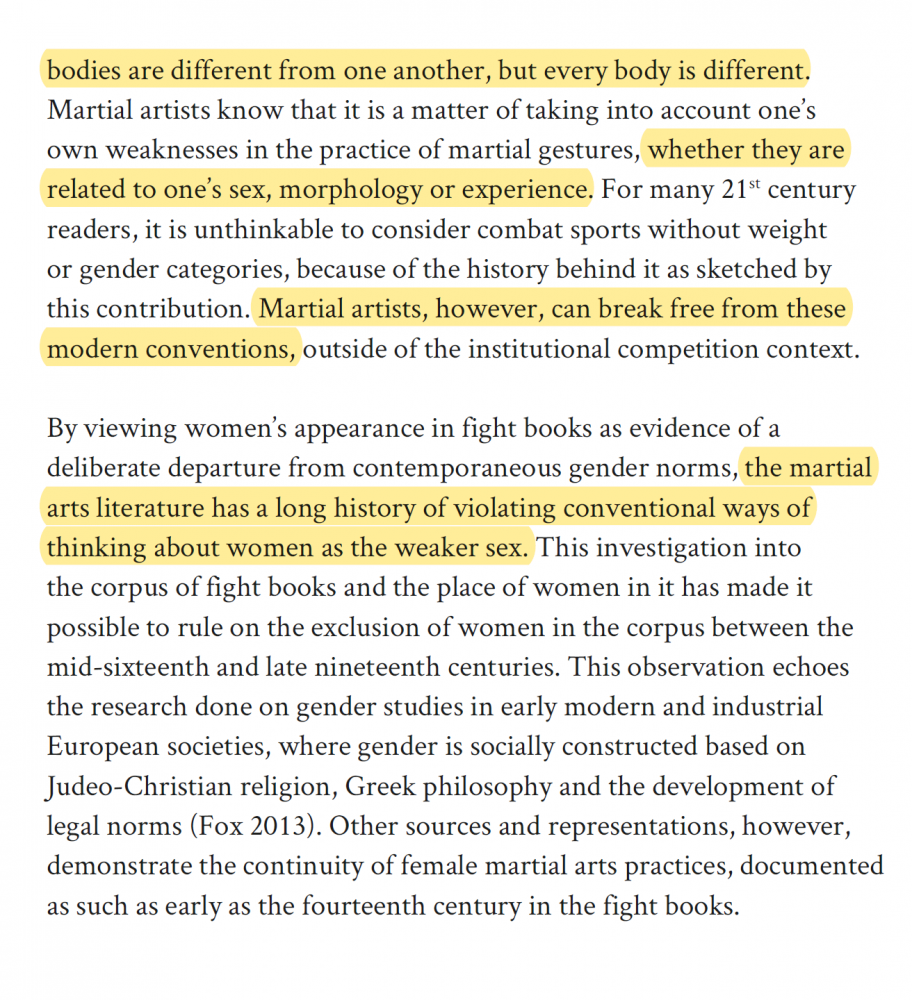

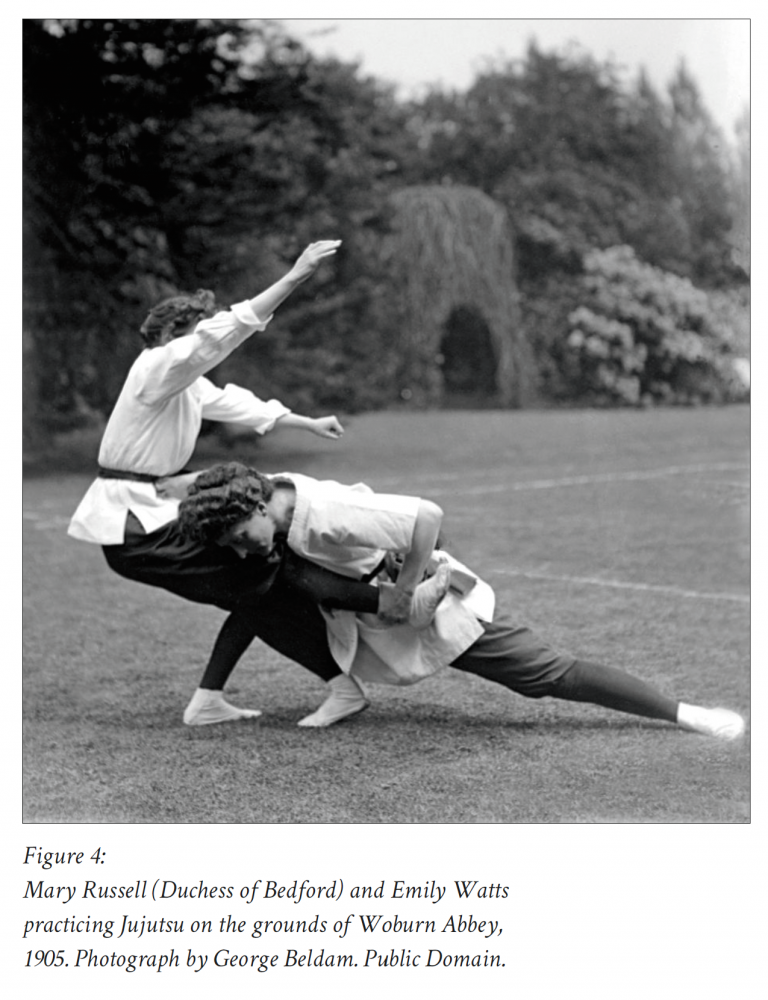
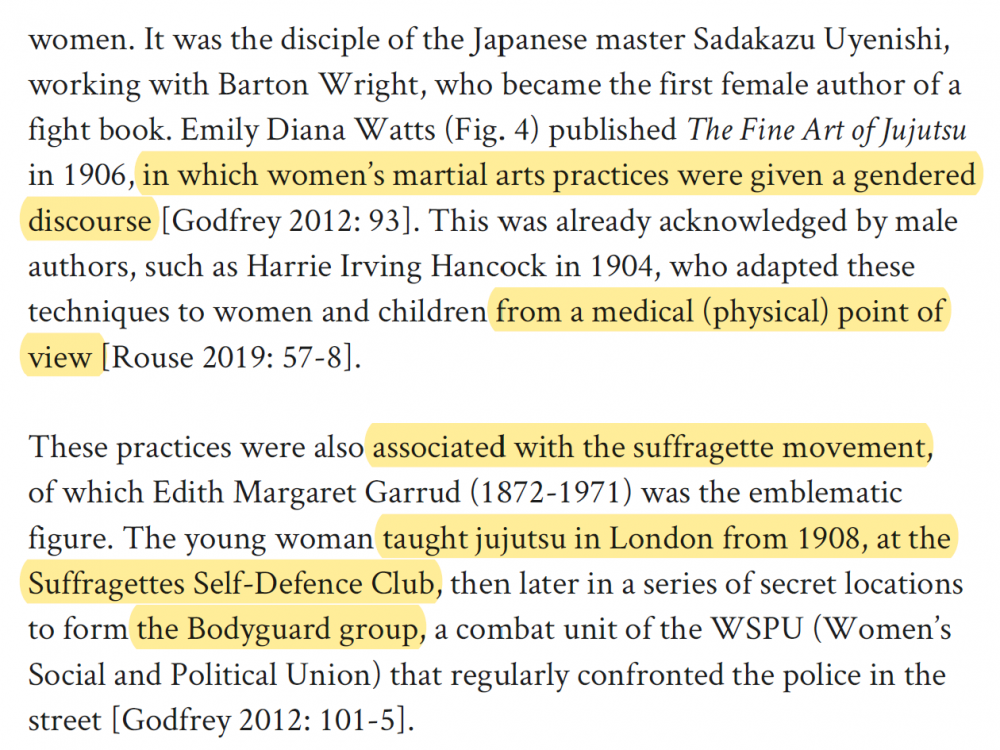
.thumb.jpg.5b2661c6373af5cb48784182cb59c38f.jpg)
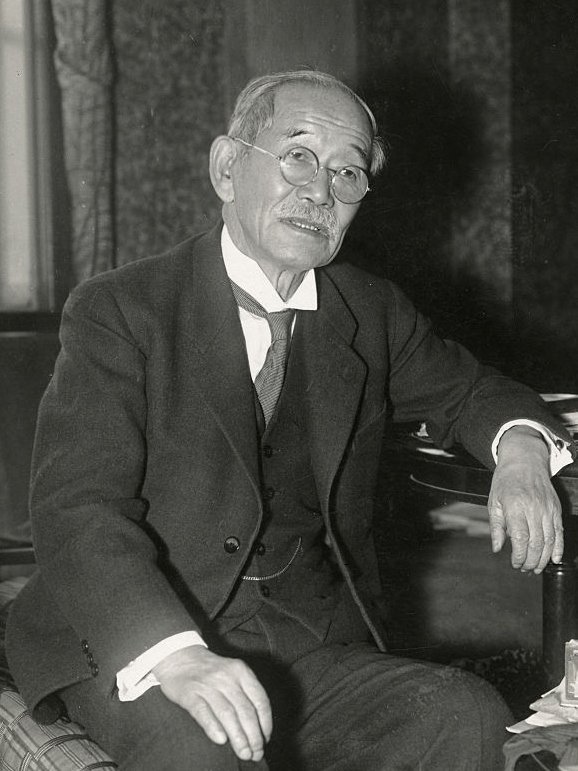
.thumb.jpg.3f2071842e33ba527b904a46d08f5366.jpg)
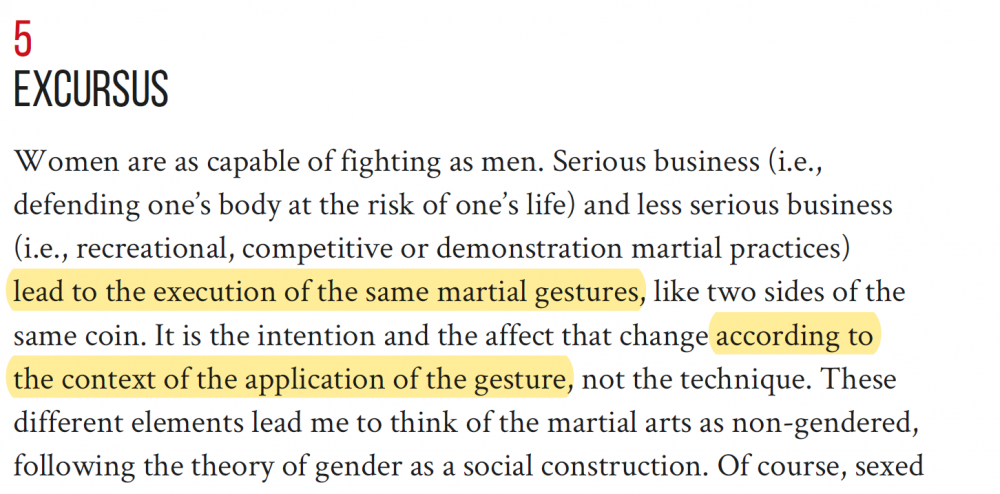


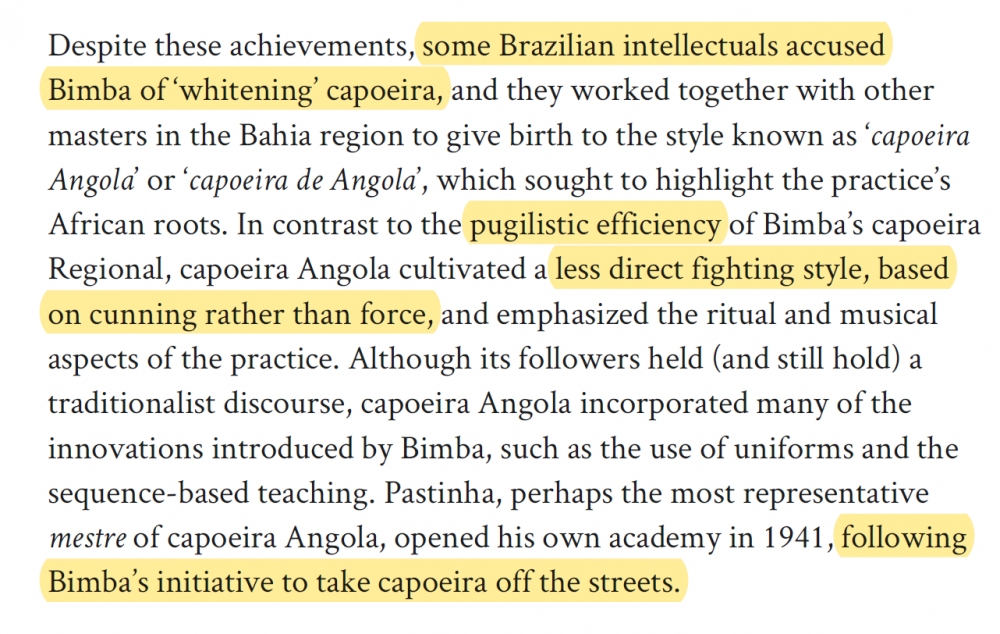
.thumb.jpg.e2839e074849ccb0bd0c246f4a22b4a6.jpg)
